© ROOT-NATION.com - Use of content is permitted with a backlink.
At the end of 2021, Motorola updated its G line, which includes relatively inexpensive smartphones with good batteries. We have already got acquainted with the G31 and G71 models, and now finally the flagship model of the series, the Moto G200, has arrived for testing. For not a lot of money, the smartphone offers an interesting design, a top-end SD888+ processor, a 5000 mAh battery, a large 144 Hz display and curious-looking cameras with a 108 MP sensor. In this review, we will figure out whether the model is worth it.
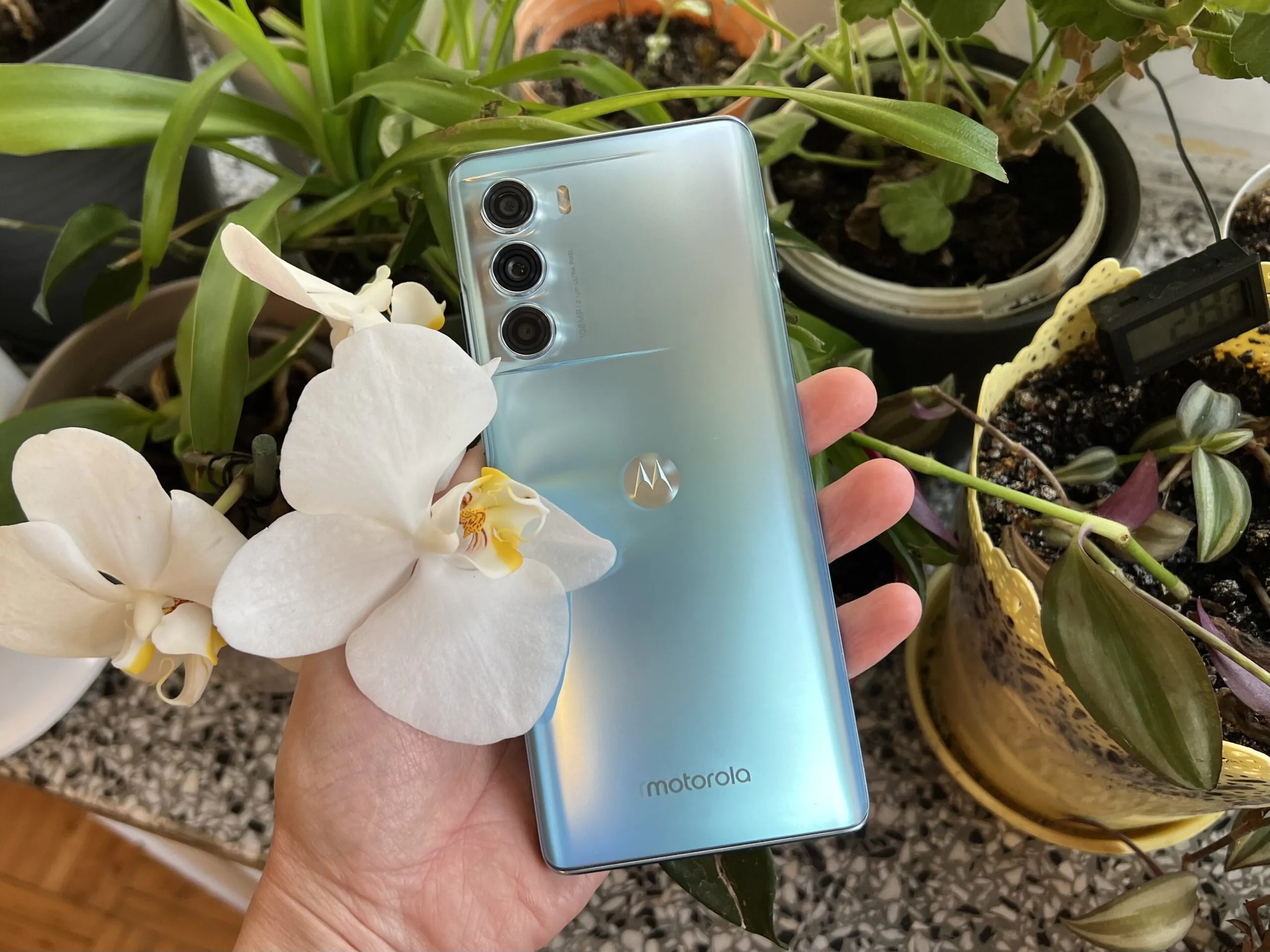
Full specifications of the Motorola Moto G200
- Screen: IPS, 6.8 inches, 20:9, 2460×1080, 144Hz refresh rate, HDR 10
- Processor: Qualcomm Snapdragon 888+ 5G (5 nm, Octa-core 1×2.99 GHz Kryo 680 & 3×2.42 GHz Kryo 680 & 4×1.80 GHz Kryo 680)
- Video accelerator: Adreno 660
- Memory: 8 GB RAM, 128 GB UFS 3.1 ROM, no memory card slot
- Battery: 5000mAh, 33W fast charging
- Main camera: 108MP f/1.9, 2.1µm + wide angle lens 13 MP f/2.2, 1.12µm 120° + depth sensor 2 MP
- Front-facing camera: 16 MP f/2.2, 1.0 µm
- Communications: LTE, 5G, NFC, Wi-Fi 6E (a/b/g/n/ac/ax 2.4+5 GHz), Bluetooth 5.2, GPS (A-GPS, LTE, SUPL, GLONASS, Galileo), USB Type-C
- OS: Android 11
- Dimensions and weight: 168.1×75.5×8.9 mm, 202 g
- Price: about $480
Positioning and price
As it is easy to guess, the Moto G200 is the flagship in the G 2022 lineup. Well, objectively, it is rather a “flagship killer”, that is, a relatively inexpensive model with a powerful processor and decent characteristics. Of course, it’s not a flagship, so there are simplifications like a plastic case, an IPS display, imperfect cameras, minimal water protection, mono speakers and so on, let’s talk about all this in more detail. But we have a top-end processor, 8 GB of RAM, 144 Hz screen refresh, and a 108 MP main camera module.
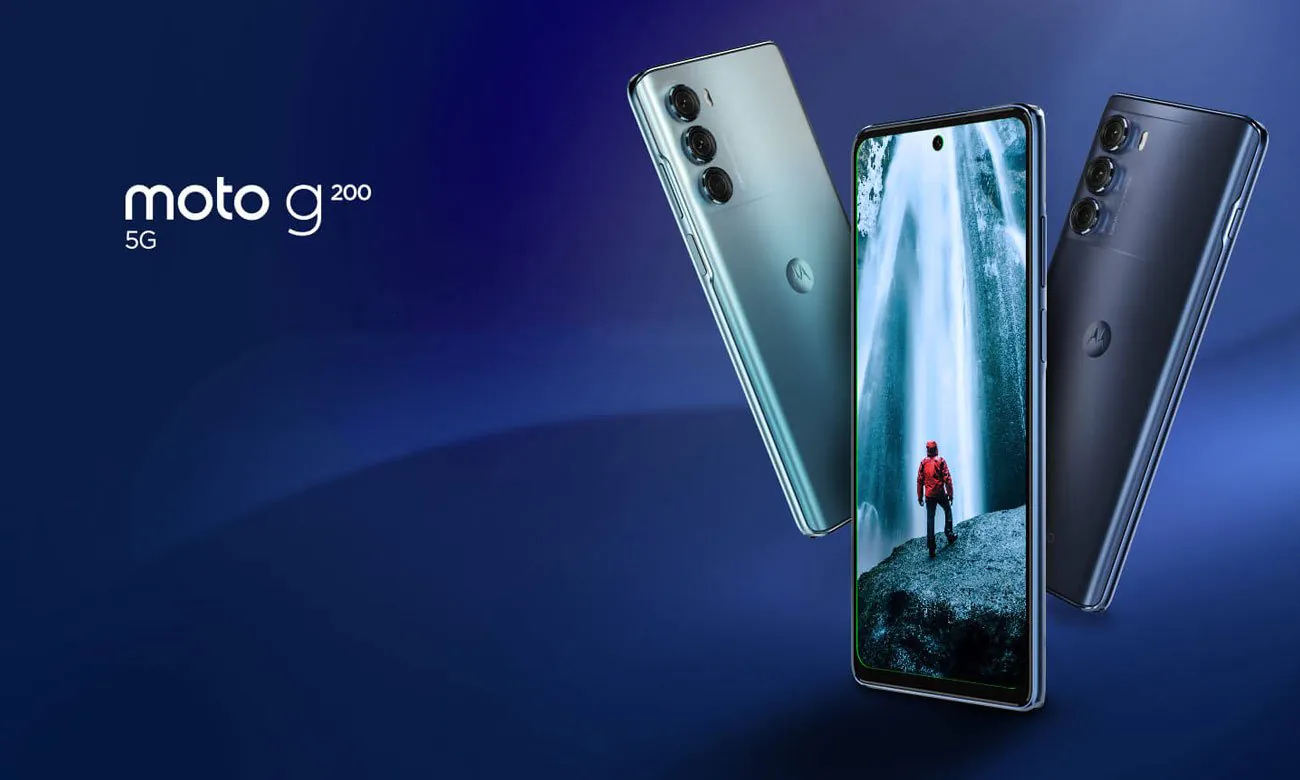
The G200 replaced last year’s Moto G100. Compared to it, it’s got a newer processor, a better screen, more megapixels, a much more beautiful and slimmer case. Among the losses is a memory card slot and a second selfie camera (not that it’s needed, so thank you). And the G200 is also cheaper compared to the G100 a year ago.
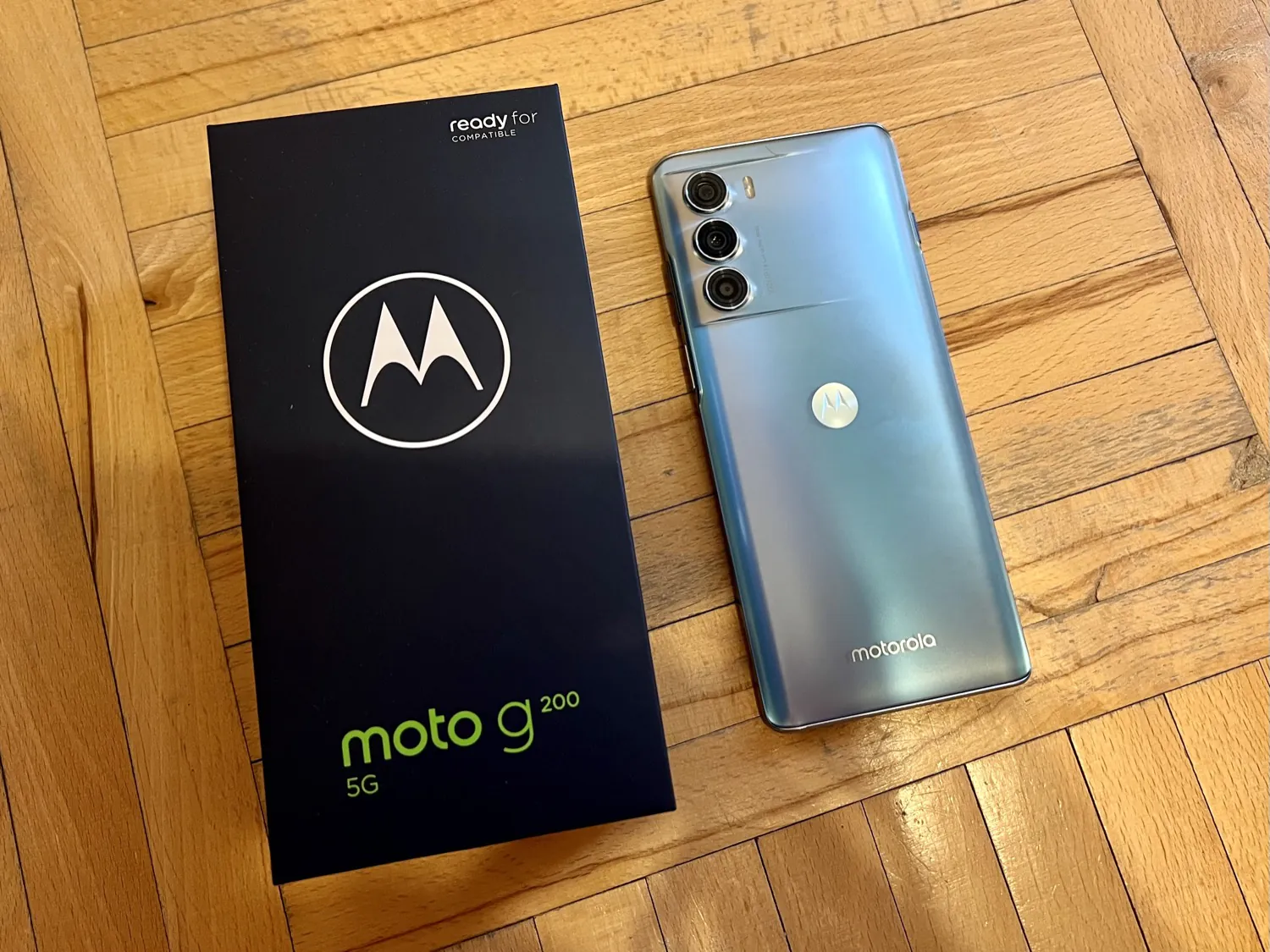
In the G line itself, the Moto G200 is followed by the Moto G71. I have already tested it, and, of course, the model is much weaker in all respects, but it costs almost $150 cheaper.
We must not forget that Moto still has a relatively fresh EDGE series. The Moto Edge 20, which I also tested, now costs the same in Europe as the G200. It stands out with a thin flat body, but the victim of beauty was the battery — only 4000 mAh. But there is a 144 Hz OLED display and a slightly more advanced set of cameras.
But the Moto Edge 20 Pro still costs about $800. And I also reviewed it, and I didn’t like the model very much. It’s not bad, but you can find much better models for the price.
However, we will do the comparison with competitors at the end of the review, and now let’s finally get acquainted with the Moto G200 in detail.
- Buy Moto G200 on Amazon
Read also:
What’s in the box
In the box with the phone you will find the standard set — a 33W charger, a USB – USB Type-C cable, a silicone case, a SIM eject tool and some documentation.
As often the case with Moto models, protective case is quite good. It’s compact, with matte sides, branded logo, edges above the screen and cameras, and protection of corners from falls. The only problem is that it will turn yellow over time, but this applies to all transparent silicone cases.
The Moto G100 also included a special HDMI cable for connecting to a PC in Ready for mode. The G200 supports both wired and wireless versions of Ready for, but, alas, you will have to buy a USB-C – HDMI cable separately. Perhaps that is also why the G200 is cheaper than the G100. By the way, the Edge 20 Pro also included the cable.
Design and ergonomics
If the G100 looked like a boring phablet, then the G200 is also like that, but not boring at all. And it differs strikingly from the rest of the dull phones of the G-series. Of course, the first thing that catches the eye is the rear panel. It’s plastic (you shouldn’t expect glass for that kind of money), but it’s beautiful. Matte, made of a multi-layered material with a transparent top layer, the shades shimmer in the light.
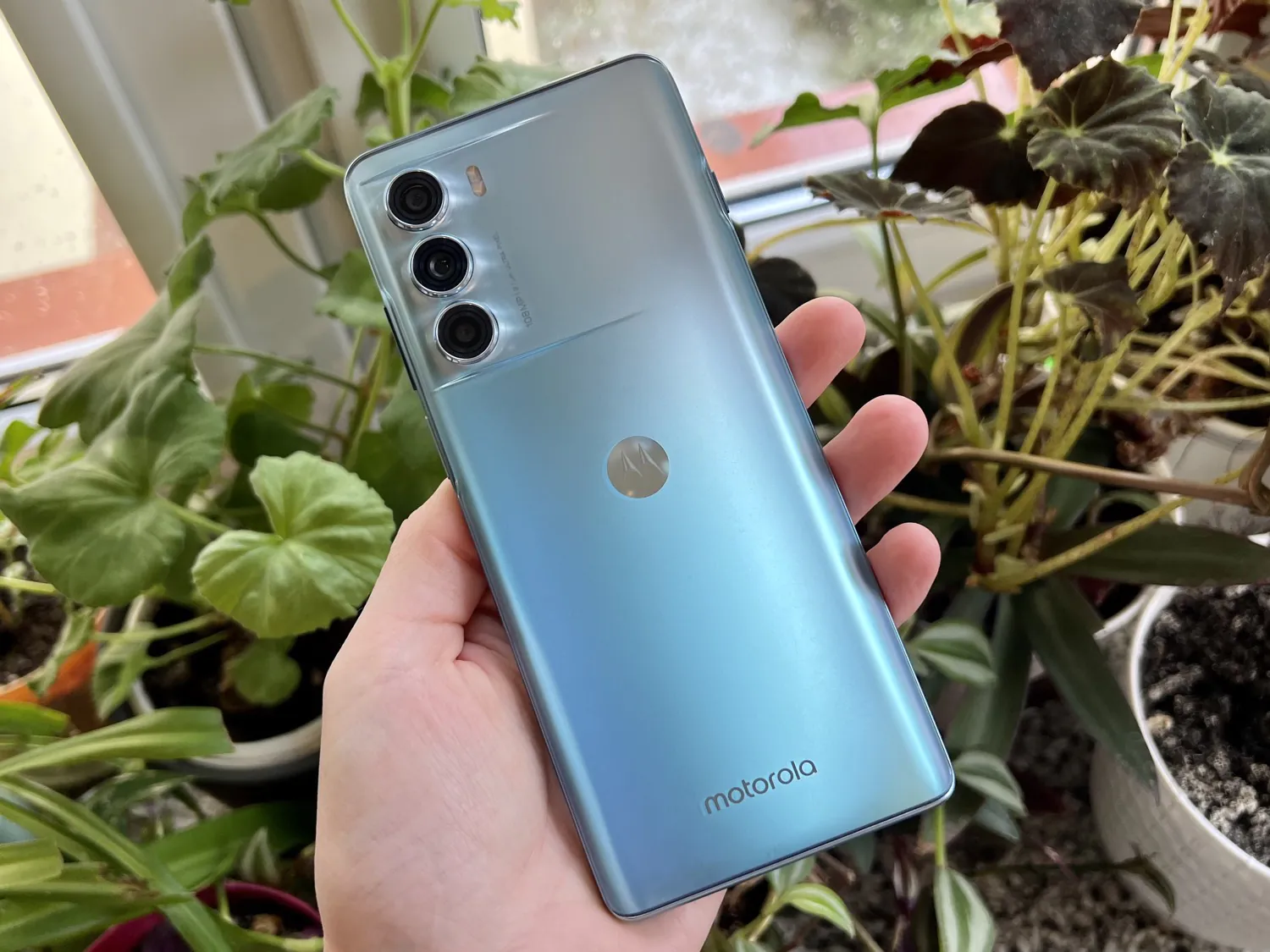
The highlight is, of course, the design of the camera unit. It rises gracefully together with a part of the case, and this translucent panel looks very impressive. Maybe not everyone will like it, but, in my opinion, it’s cool and unusual.
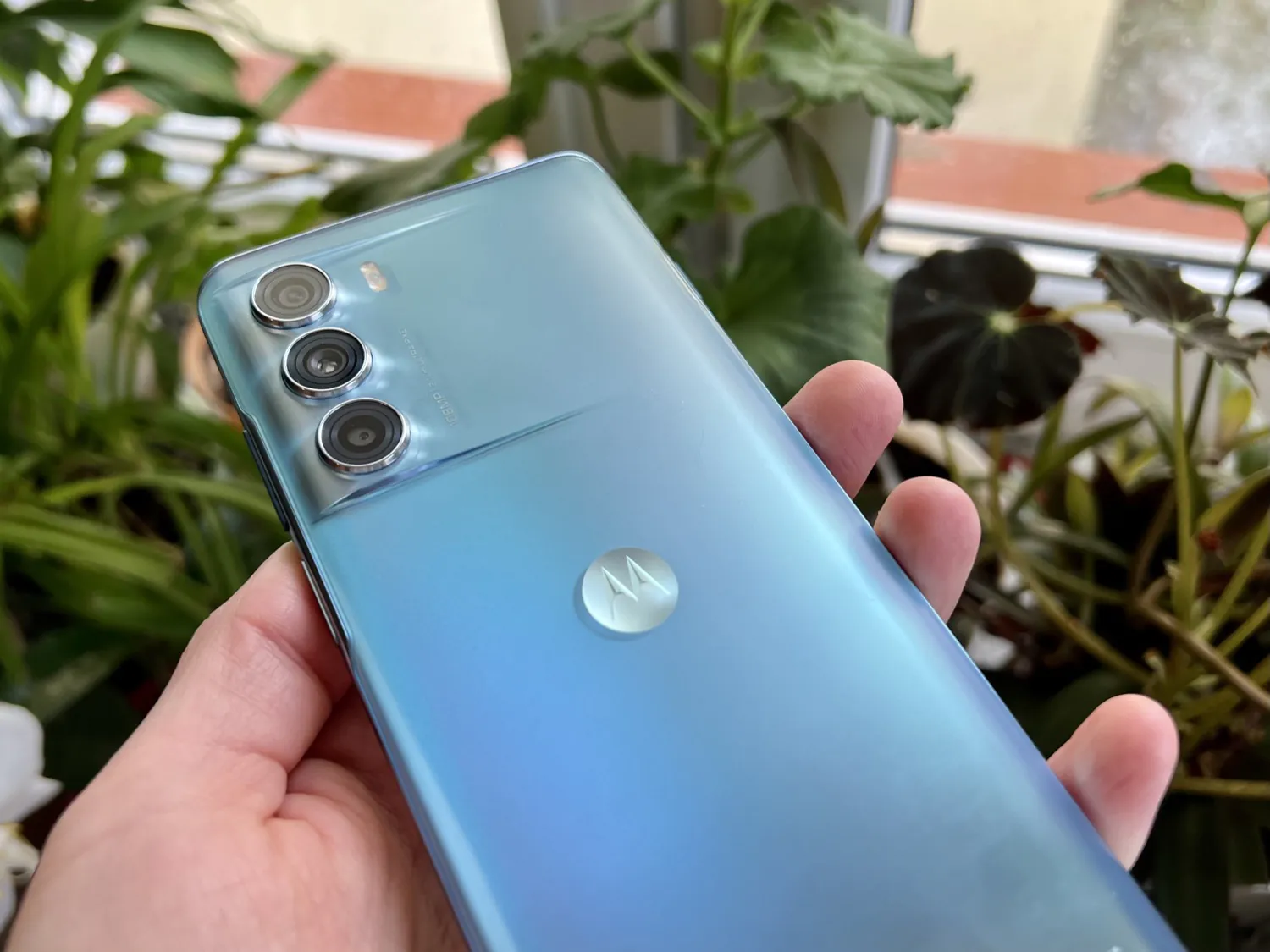
I was afraid that the back panel would turn out to be a fingerprint magnet, as happened with the G71, but – nothing like that! The panel, of course, collects fingerprints, but not too much. It is quite possible to use the phone without a case. And the back panel does not slip in your hands, the phone is quite firm in the palm of a hand.
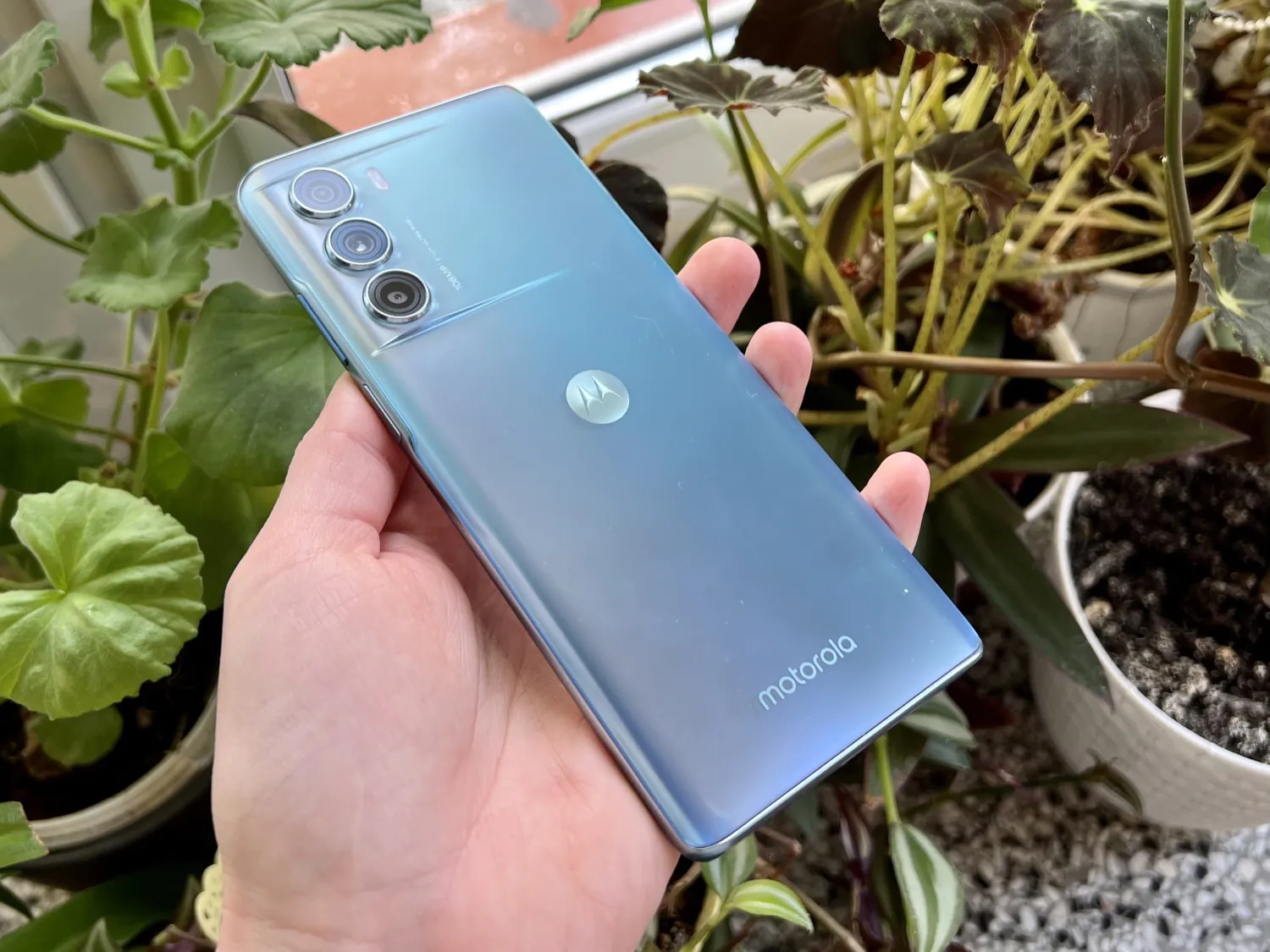
The upper edge of the smartphone received an insert of the same color and material as the back panel. I saw something similar on the example of the OPPO Reno 6 Pro – it’s quite stylish.
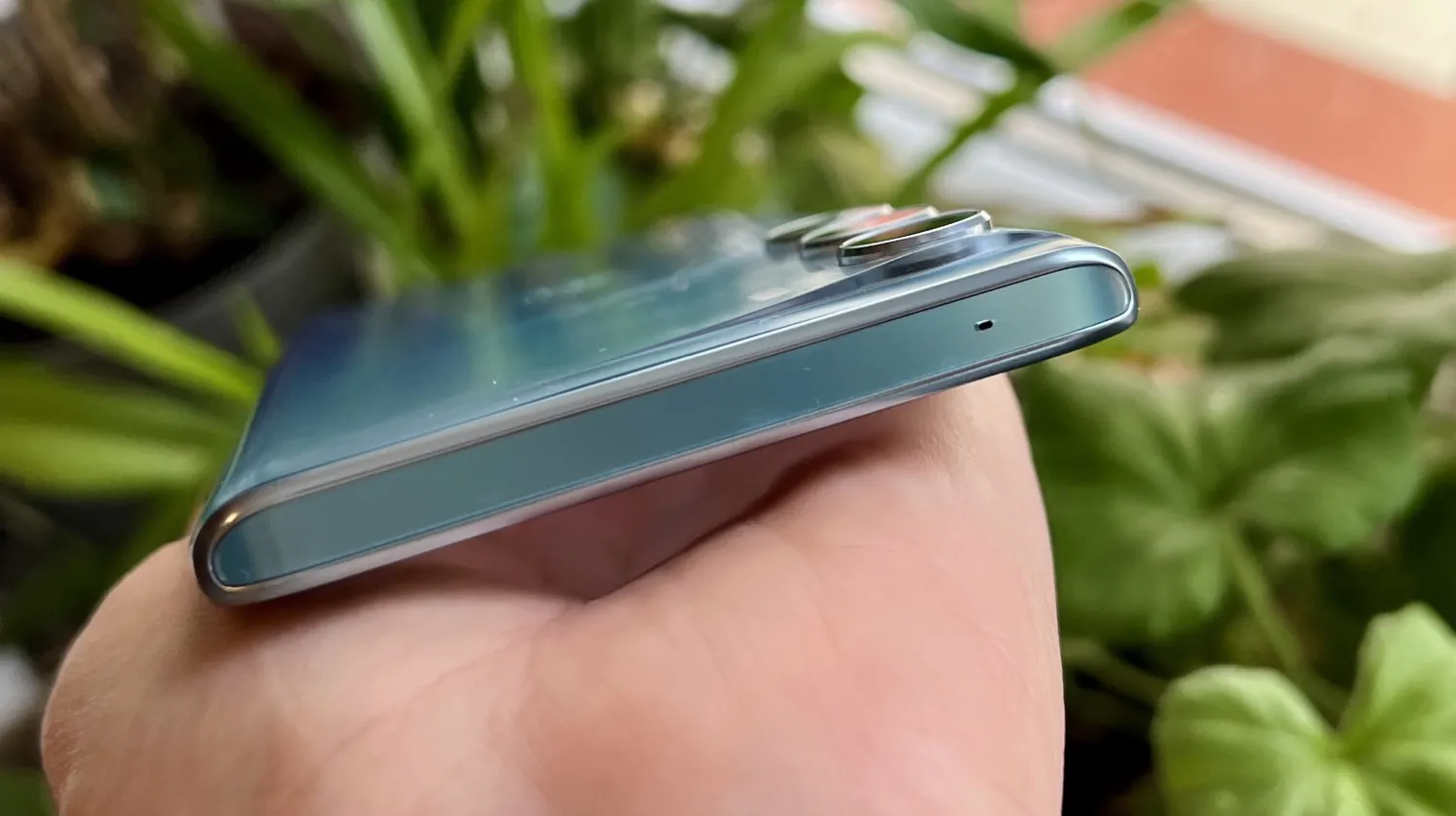
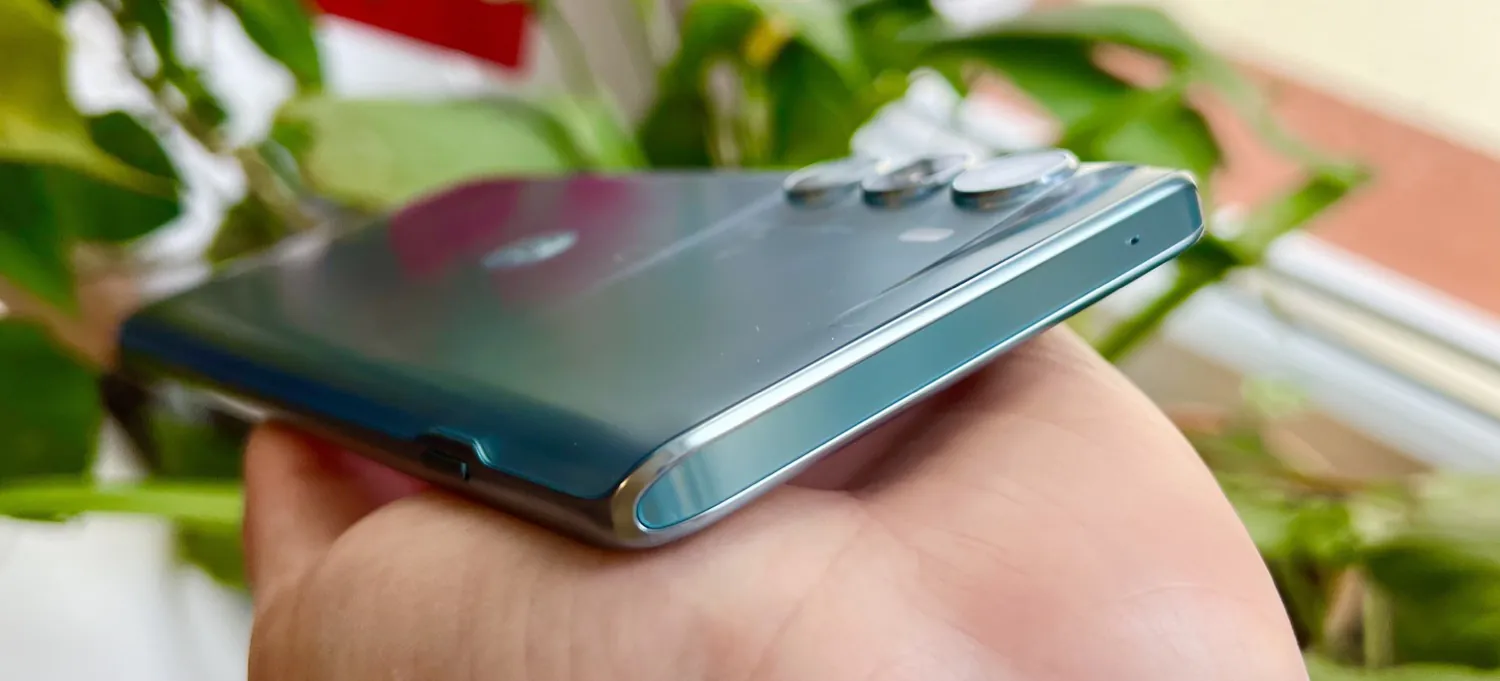
The edges of the back panel are beveled, due to which the smartphone lies comfortably in your hand. And it looks great too.
The body of the case is similar to metal, but it is also plastic. Some think it’s a bad thing, but personally I did not expect anything else in a relatively inexpensive model. In addition, plastic reduces the weight.
The bezels are thin, only the “chin” stands out, but for an inexpensive model this is excusable. The front-facing camera is embedded in the screen, its “window” is too large, but again this is not critical, especially considering the huge 6.8-inch display.
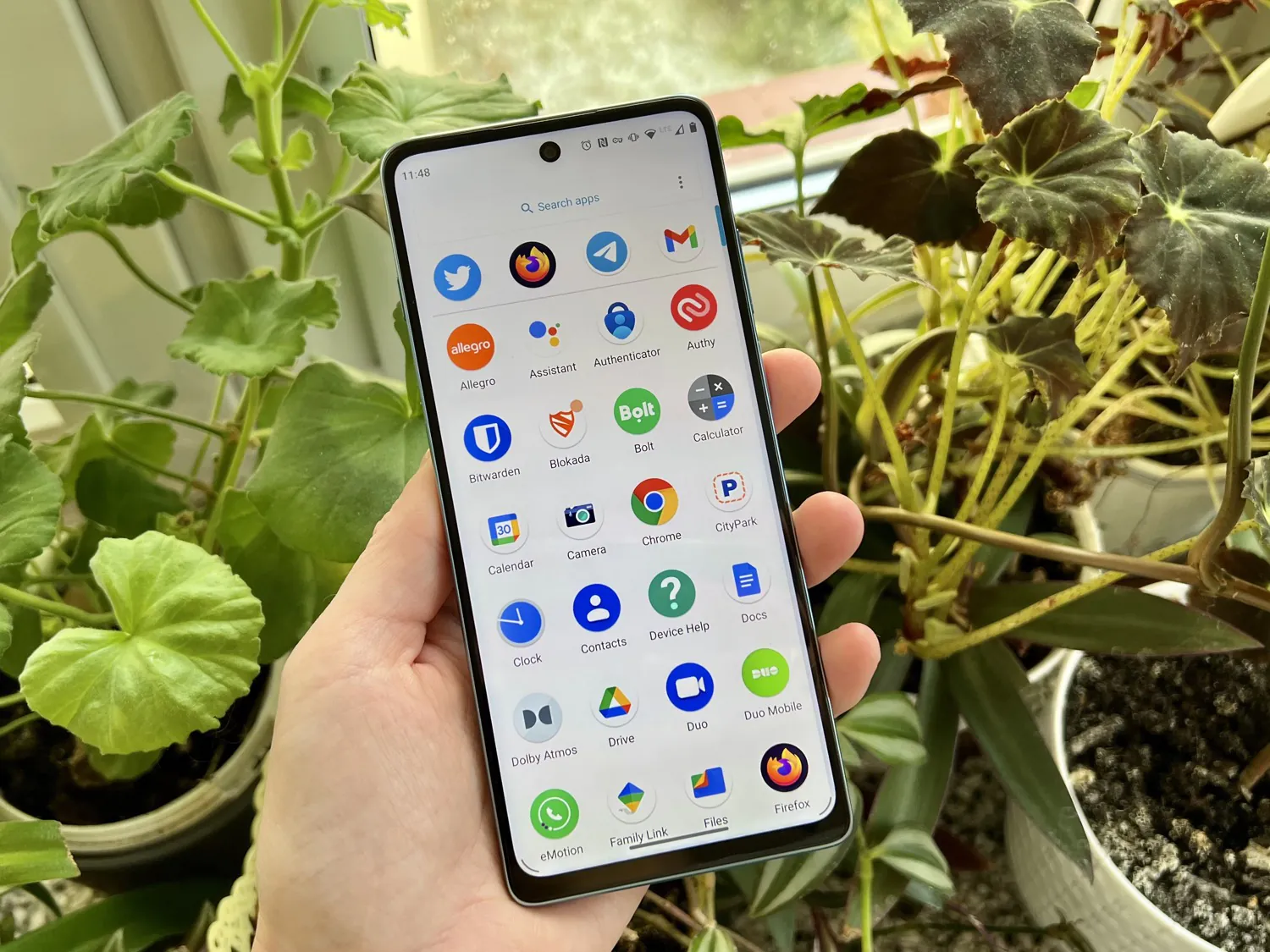
The edges of the display are lightly beveled, good for gestures from the edge of the screen.
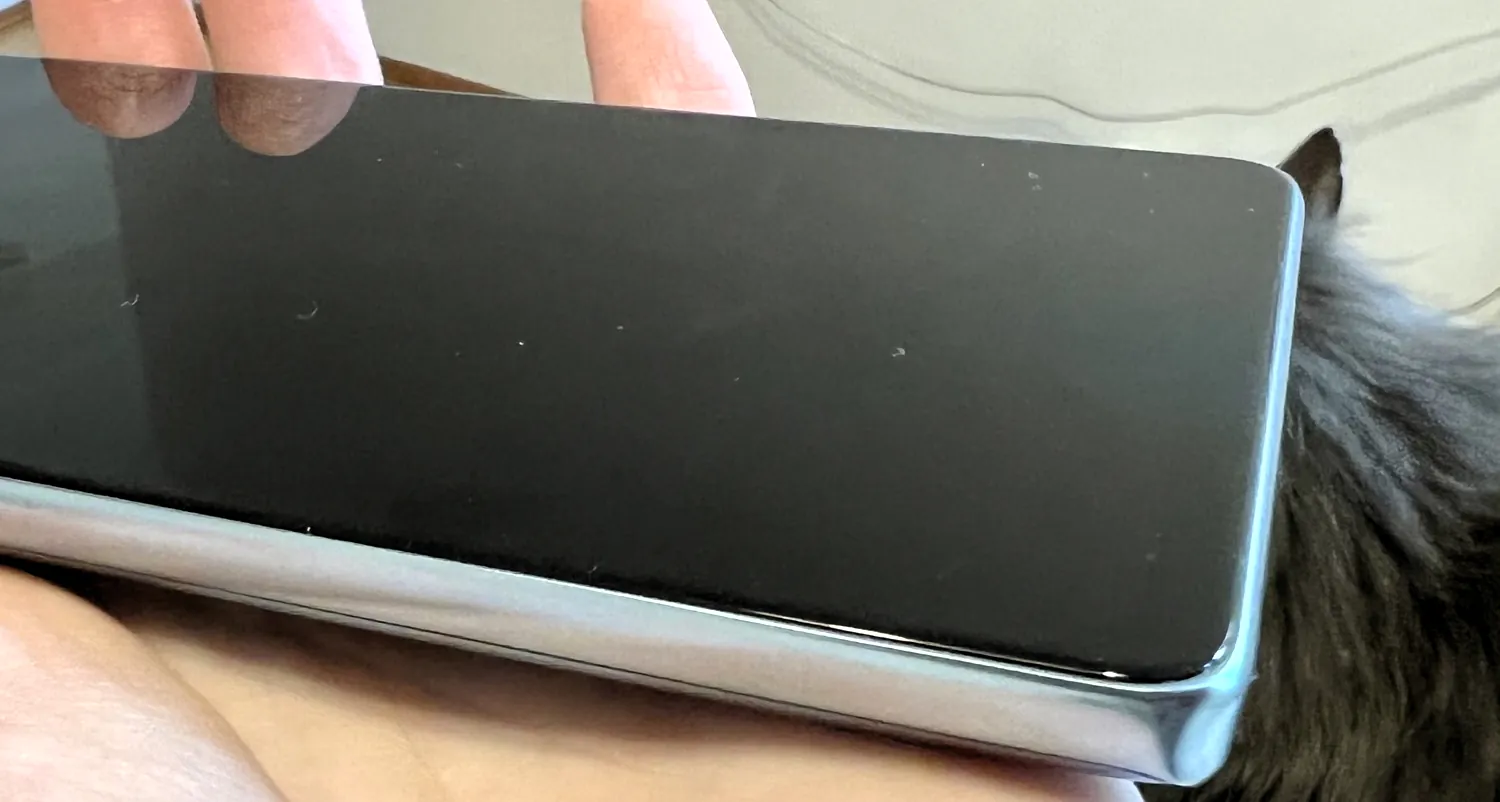
Motorola doesn’t specify what type of glass it uses, but it’s not Gorilla – again, to save money. Of course, there is an oleophobic coating, but it doesn’t save the screen from fingerprints.
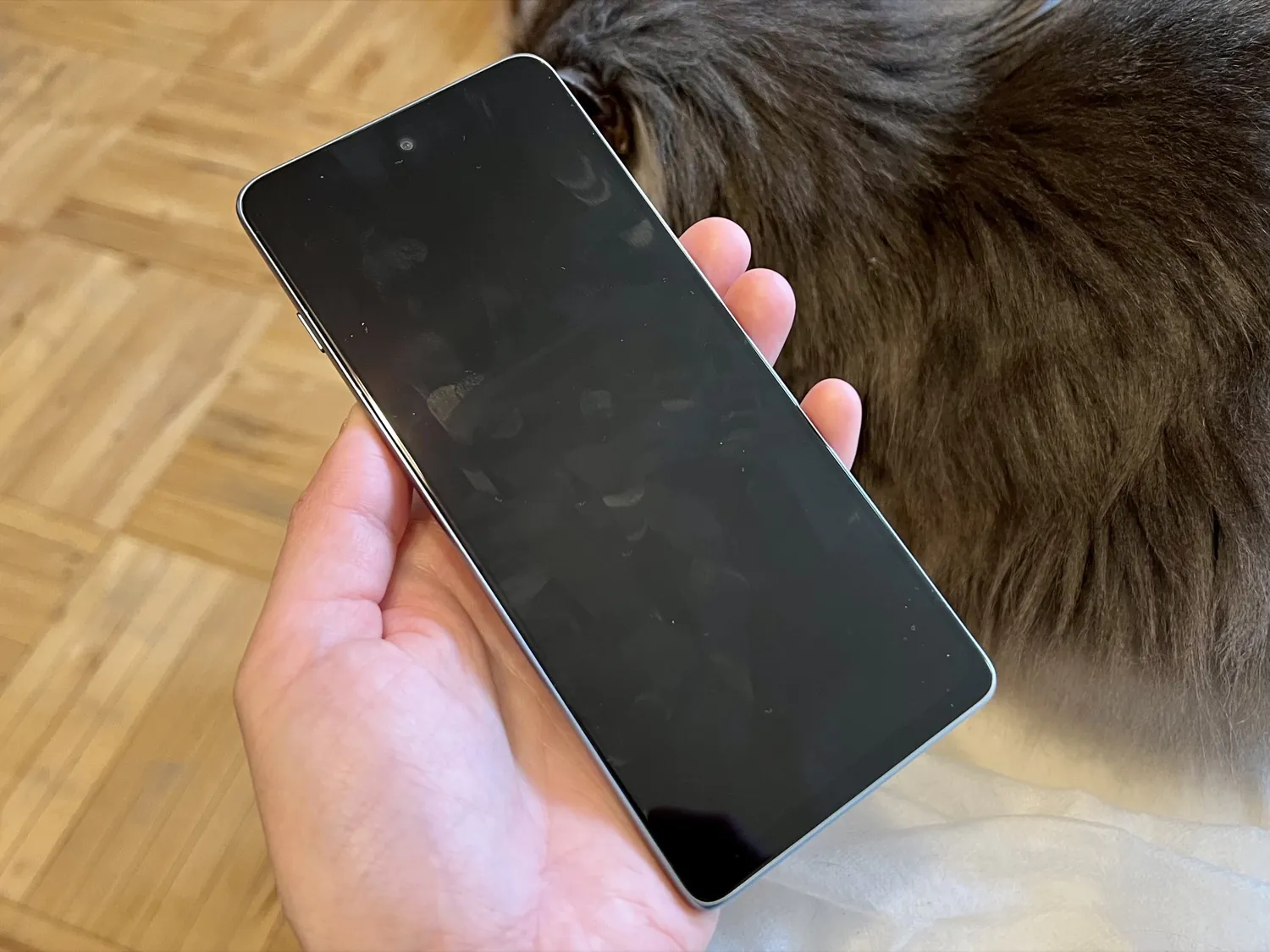
On the left side of the smartphone there is only the Google Assistant call key. It’s usual for the brand and you can basically just ignore it. There’s nothing else to do anyway — you can’t disable or reassign it.

On the right side there is a volume control key (located, in my opinion, too high), as well as an on/lock button, which has a built-in fingerprint sensor. You can’t embed an on-screen sensor into an IPS screen, and for some reason Motorola doesn’t like such solutions in principle. The fingerprint scanner in the side key is a simple and convenient solution. When you take a smartphone in your hands, your finger falls right on it. The reading is fast, error-free. There is, of course, face recognition, but personally I prefer fingerprint unlocking.
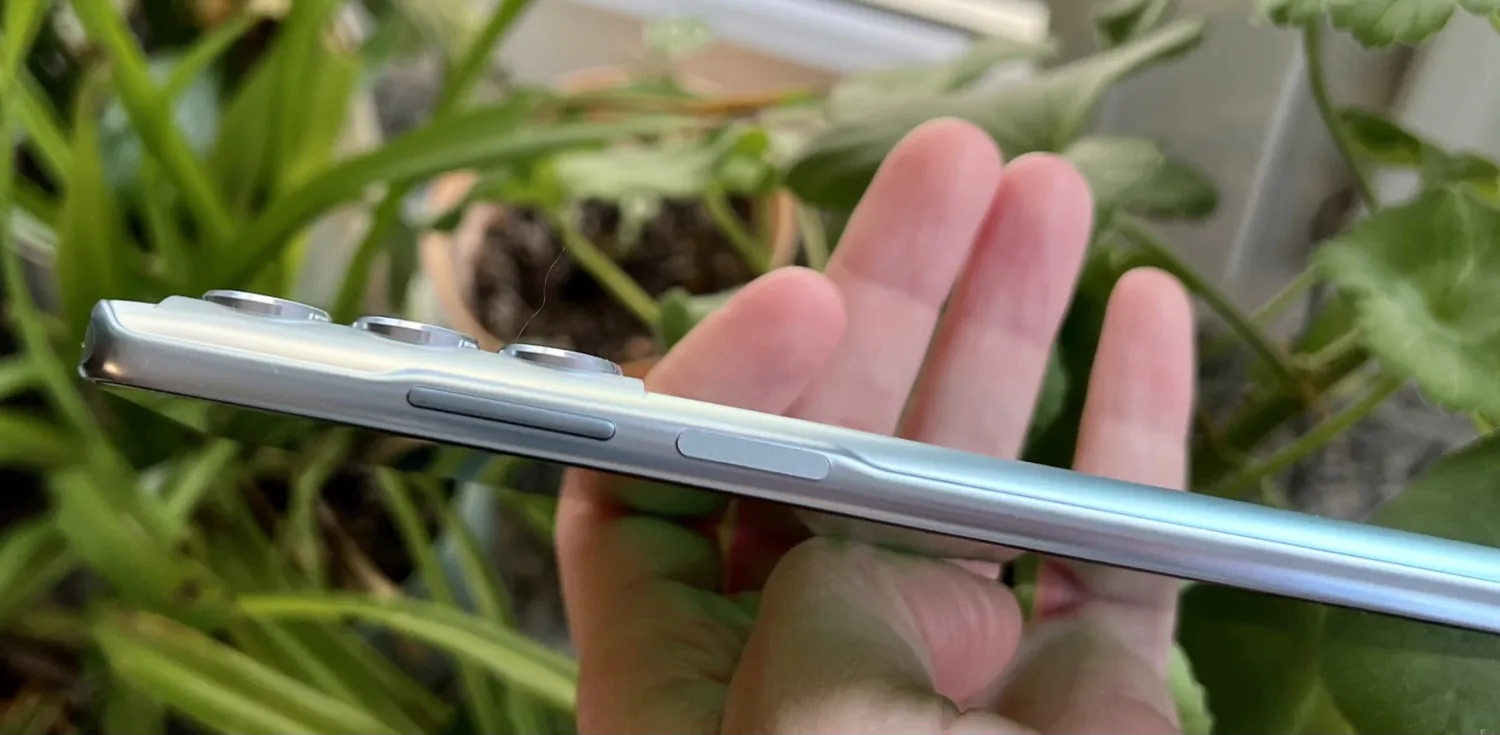
You can double-tap the lock key to open a customizable menu with the list of apps.
On the upper end of the smartphone there is a microphone that performs the noise reduction function. On the bottom there is another microphone, a Type-C connector, speaker holes (unfortunately, there is only one) and a slot for two SIM cards (there is no support for memory cards). There is no 3.5mm headphone jack either.
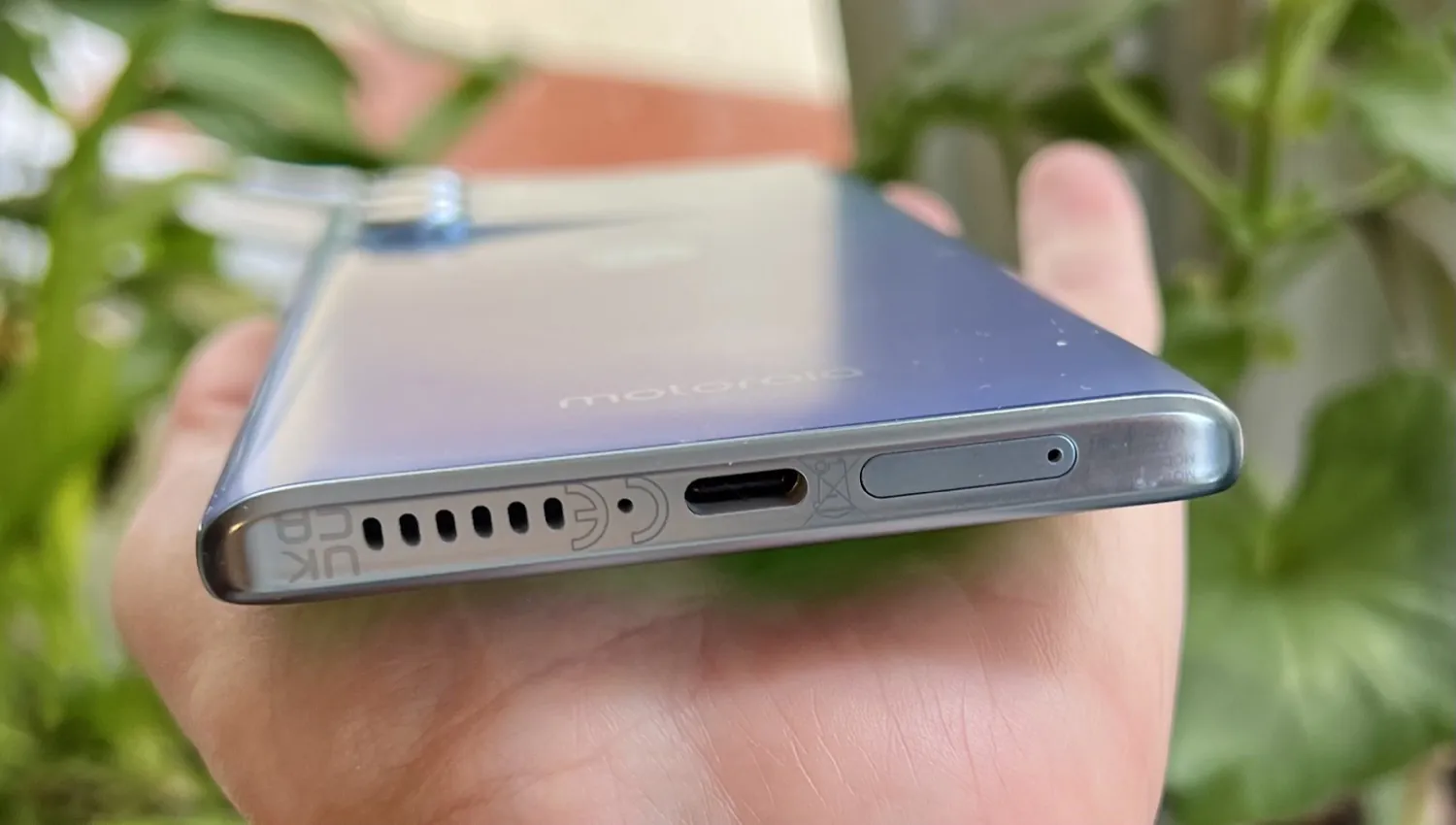
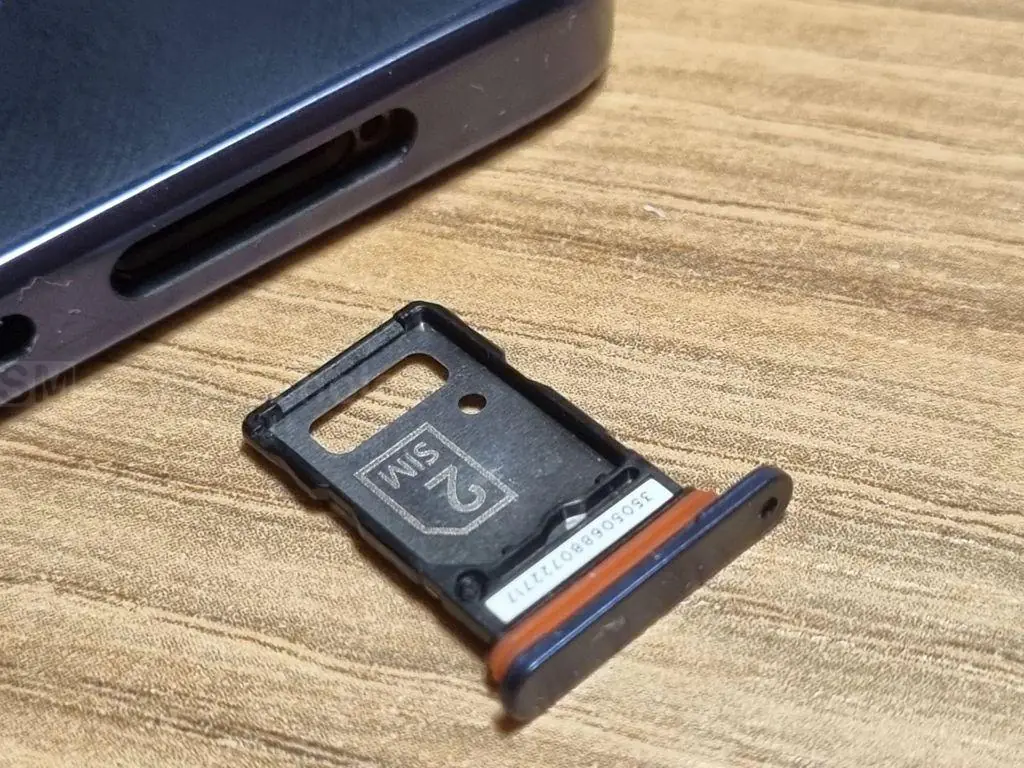
Now let’s talk about the dimensions of the smartphone. Be mentally prepared for the fact that it is HUGE. The 6.8-inch screen is some serious stuff.
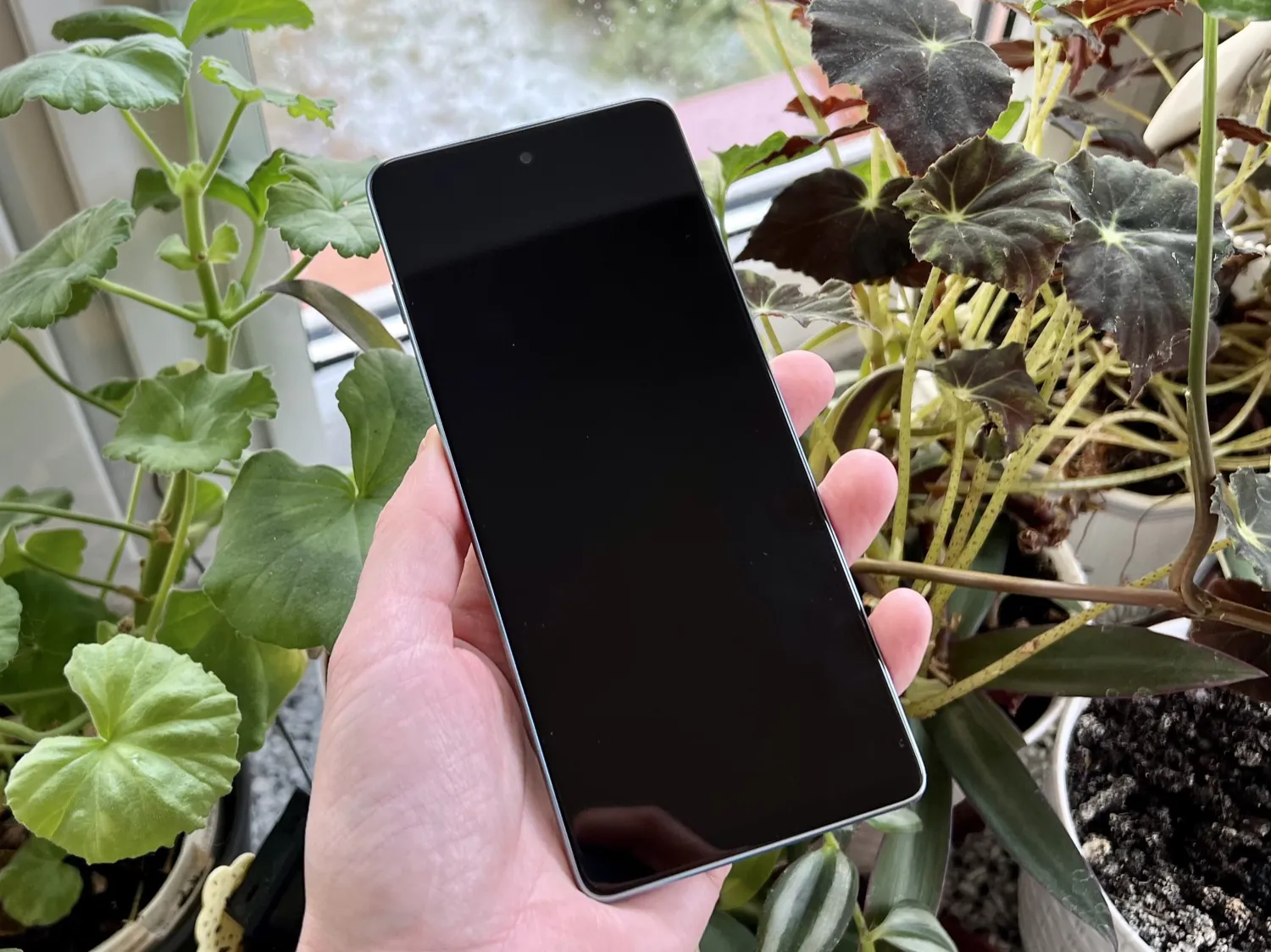
I took a picture of the Moto G200 and my iPhone 13 Pro Max next to it. Bear in mind that the iPhone is also huge. The G200 seems even bigger! But this does not mean that ergonomics is worse than that of the largest iPhone. The Motorola has a relatively thin body (8.9 mm) with beveled edges. At the same time, the phone is narrower, but taller. Thus, it is easier to control the G200 with one hand, at least you can reach the other edge of the screen with your thumb. But a longer screen means that reaching the upper UI elements is a problem, you need to use the second hand or change the grip.
Personally, large screens do not frighten me, I believe that modern phones are not strictly phones, but devices for consuming a variety of content. And a big screen is better for that. But all people are different, it’s better to try the device before buying to understand what you think of its dimensions. I think I would be more shocked if I didn’t use the iPhone 13 Pro Max every day. But 200 g is quite adequate for such a large phone as the G200 (the iPhone is heavier), and it is well balanced.
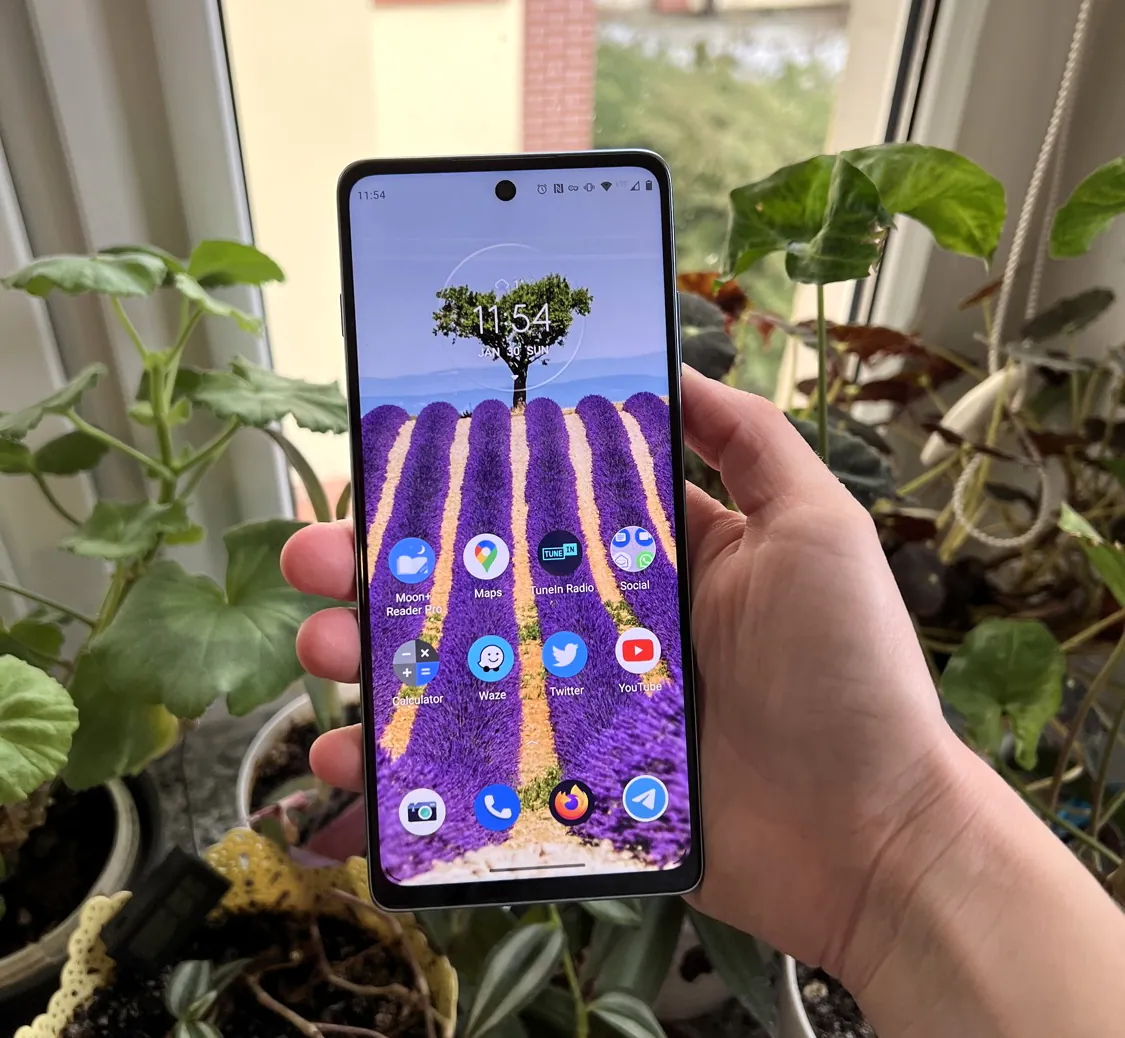
Moto G200 is available in two colors – Glacier Green and Stellar Blue. We tested the first variant, which is sorta bluish-green, sometimes tinged with purple.
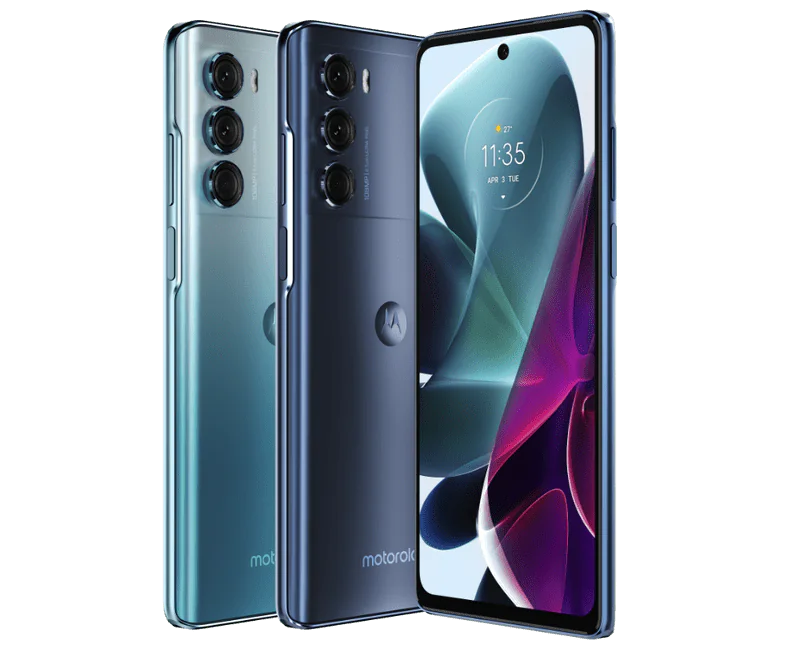
The build quality is perfect. Besides, the Moto G200 case has a hydrophobic shell, is not afraid of a bit of rain (IP52).
Read also: Motorola Moto G31 review: affordable OLED smartphone
Screen
While competitors use bright and juicy OLED screens, Moto prefers to save money and installed an IPS matrix display in the flagship G-series. There is support for HDR10 and DCI-P3 color gamut. This, of course, is not OLED, which is obvious — it’s not as saturated, the black color is not as deep, the contrast and brightness are somewhat lacking. But considering the cost, the quality is sufficient, an ordinary buyer will not find anything to complain about.

But it’s not all bad news: the refresh rate of the screen is 144 Hz. The picture is smooth and impressive. There is even a feeling that the smartphone works faster compared to models with a standard 60 Hz frequency.
There are three modes of operation: automatic (the phone will set itself depending on the app and the charge level), 60 Hz or 144 Hz.
In the settings there is an option to adjust the color temperature of the screen. There are also three hue saturation options available.
It is quite difficult to check this in winter, but, apparently, under the bright sun, the G200 screen fades somewhat, which is a feature of IPS.
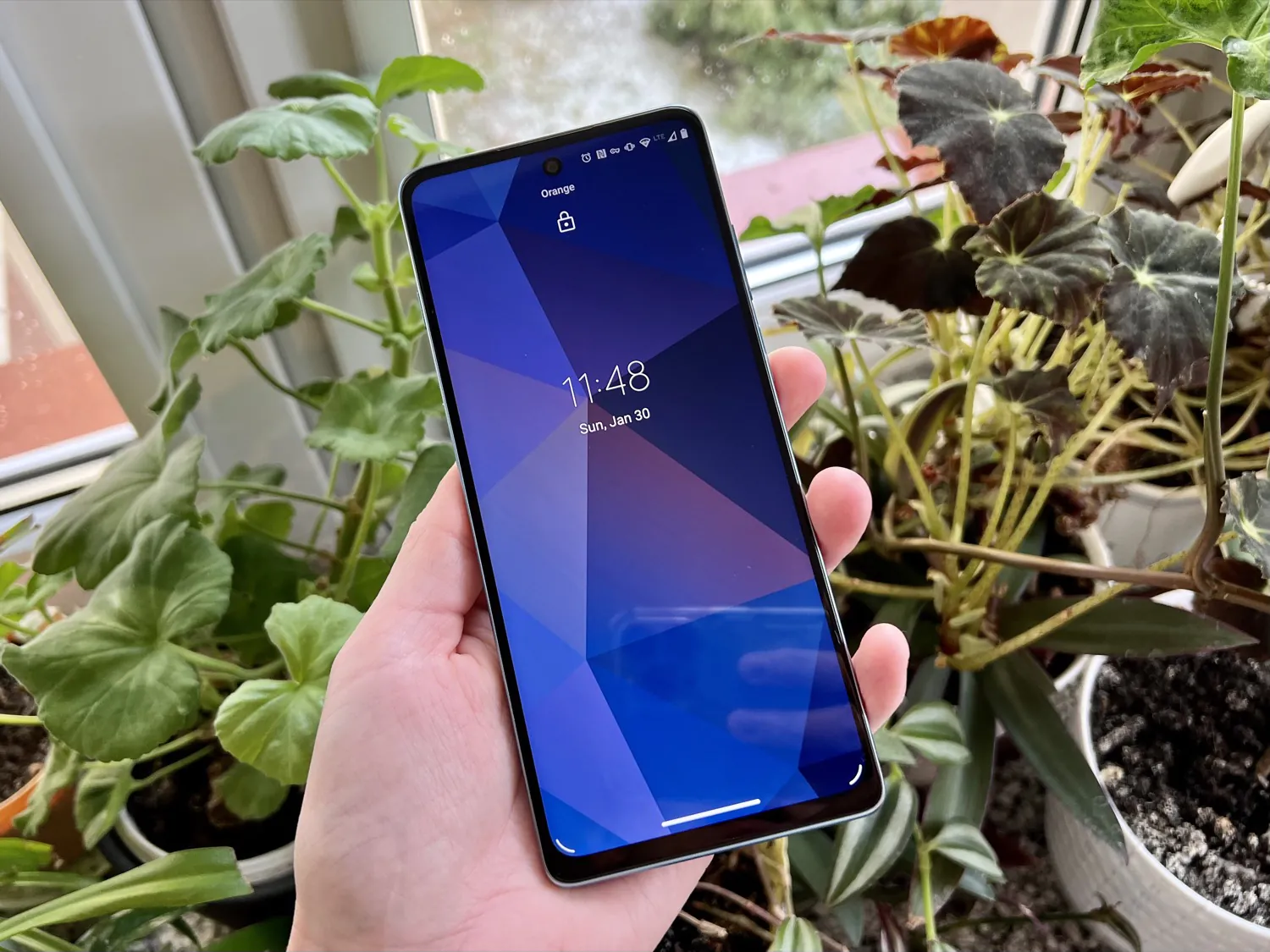
Read also: Motorola Moto G71 review: the best of the rest
Hardware and the performance of the Moto G100
In a relatively inexpensive model, Motorola has installed the most advanced processor of 2021 — Snapdragon 888+. In 2022, the new Snapdragon 8 Gen 1 model became the king of benchmarks (and the Moto X30 based on this chip has already been announced). But the 888 will remain relevant for a long time.
888+ was announced last summer, compared to the original SD888, the frequency of the main core has been increased. Of course, there are no issues with the performance of the Moto G200.
The amount of RAM is 8 GB, and there is 128 GB (fast type UFS 3.1) of storage. Theoretically, there is an 8/256 GB version, but it has not yet appeared on the European market. For some, this may be critical, since there is no memory card slot.
Recently, a software RAM expansion function has appeared in the Moto shell. 2 GB can be added to the existing 8 GB. That means that a total of 10 GB of RAM can be used.
I’m not a fan of running synthetic tests on phones, but if you are fond of numbers, then I inform you that in AnTuTu the smartphone scored 808800 points, in Geekbench it got 1028/3155 points (single core/multi core), and in the 3DMark Wild Life it got 5717 points.
Personal impressions are more important. I can say that the performance of the Moto G200 is excellent, with no freeze or lags, even in the most demanding tasks or heavy games, with a large number of apps running simultaneously. The performance of the model will definitely last for a long time.
When tested, the device becomes warm, but not hot. Of course, it depends on the nature of the task. For example, in the 3DMark Wild Life stress test, the device warmed up to 43 degrees, and you could feel it. Unsurprisingly, the SD888 chipsets are considered “hot” by default. But still, in everyday use it’s fine. Even games like PUBG aren’t really a big deal. The drop in performance in the stress test is about 17%.
Read also: Motorola Moto G60 review: Budget phone with 6000 mAh and 120 Hz!
Cameras
The smartphone received three camera modules on the back panel. The main sensor (Samsung ISOCEL HM2 1/1.53″) has a high resolution of 108 MP. However, do not think that your photos will have a resolution of 108 MP. The technology of combining pixels is used, at the output we have 12 MP images, but clear and detailed. In the settings, you can also enable the full 108 MP resolution, but such photos will take longer, take up more storage, and there is still no fundamental difference. Electronic stabilization is there, but no OIS. Night mode supported only the main lens.
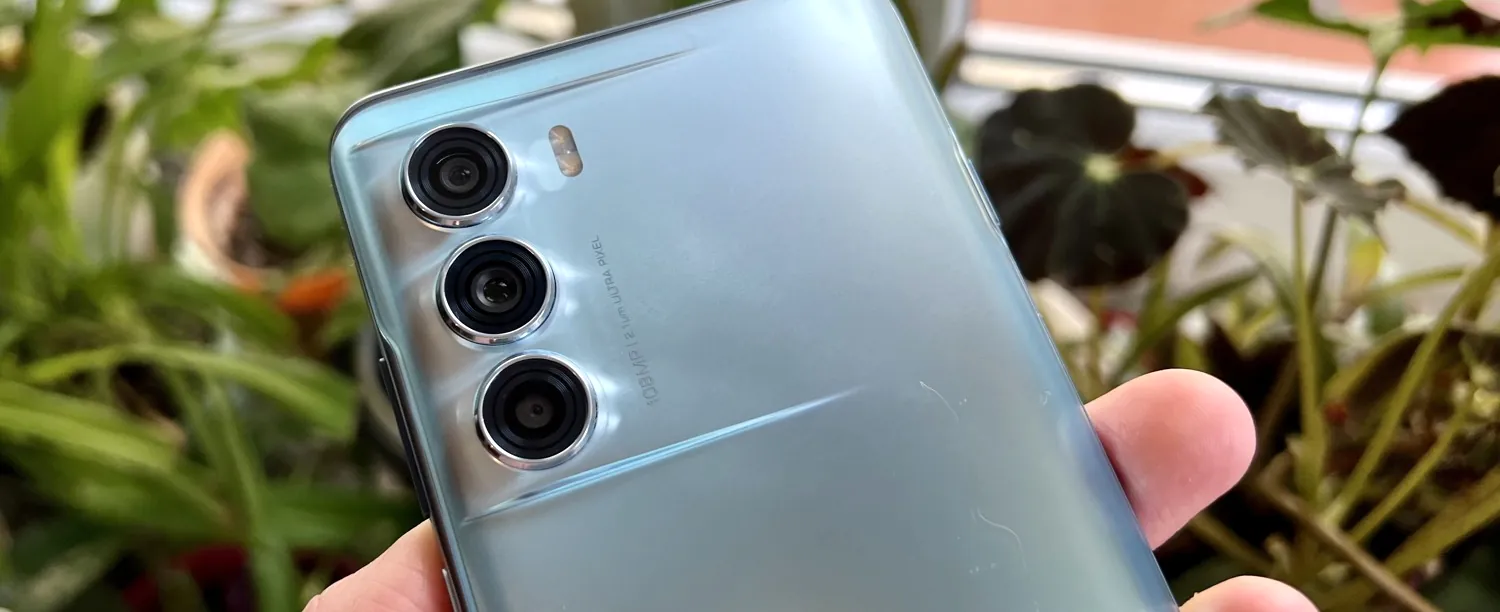
The ultra-wide-angle camera received a 13-megapixel sensor. Thanks to the presence of autofocus, such a camera allows you to take macro photos from a distance of 3 cm, a similar solution was found in the Edge 20 Pro model. As my experience shows, it is better to use this option for macro shooting than a separate low-quality macro lens.
There is also a 2 MP depth sensor, it is auxiliary and serves to blur the background of the photo.
The selfie camera has a 16-megapixel sensor, the focus is fixed.
Let’s talk about the quality of the photo. As you would expect, with good lighting, everything is fine. The pictures are clear, well detailed, with a pleasant color reproduction. Of course, they are not the same as the flagship Samsung or iPhones, but we must understand that this is not a very expensive smartphone. In any case, the vast majority of users will be happy.
If the lighting weakens, then the possibilities of the Moto G200 fall. Even with weak home lighting, it is difficult for the camera to focus immediately, color reproduction and clarity deteriorate. However, if you show patience and hold the phone still, you can get decent pictures.
When shooting outdoors at night, the lack of optical stabilization is critical, photos are often blurry.
For photos in low light and in the evening, you can use the night mode, available only for the main 108 MP lens. It does not turn the pictures into excessively highlighted mess. And it often adds clarity to them, since when shooting in this mode, several photos are created, which are then combined. But the quality, of course, is falling, digital noise is noticeable, blurred small elements appear. Here is a comparison: photos in normal mode on the left, night mode on the right.
10x zoom option is also available. Considering the price category of the phone and the lack of an optical stabilizer, I can say that it shots surprisingly well! In the examples below, you can see usual photos, then a crop of 5x, then a crop of 10x (link).
The wide angle is not bad, the photos are good, with decent contrast and dynamic range. The detail is not very good and you can find fault with the color rendering (when compared with the main lens), but most users will still be satisfied. Below is a photo from a standard lens (left) compared to a photo from a wide-angle lens (right). (Full resolution shots here)
The wide-angle camera has autofocus, so it can take not only “wide” pictures, but also macro from a distance of 3 cm. You can get really beautiful close-up shots. Take a closer look at the examples — you can even see the structure of the leaves! However, for good shots, you need to keep the camera as still as possible, and the lighting should be perfect. In any case, the macro mode is not useless, as with many phones of medium and low price levels.
The 16 MP front-facing camera takes clear selfies with natural color reproduction. There are AI options to improve the photo – beatification, compensation for low light.
The Moto G200 supports 8K video recording, but only at 24 frames per second. There is also 4K at 30 or 60 fps. When shooting in 8K, the phone kind of makes a crop of the frame, turning on 1.7x zoom compared to 4K or 1080p.
In general, the video quality is at a decent level. Electronic stabilization does its job (missing in 8K mode). Below are examples of videos in different resolutions. (files)



One of the interesting features is recording super-slow video at 360 fps (in HD mode, in FullHD it works with 120 or 240 fps). There is also the possibility of double recording on the main camera and the front-facing camera at the same time.
The camera interface is standard for Moto. Sometimes users complain that you won’t find the right modes or settings right away, but I didn’t have any problems.
In addition to standard shooting modes, there are also “selective color” (leaves one color on the photo), panorama, “live” photos, real-time filters, PRO mode with RAW support.
Data transfer and Ready for mode
Everything is fine with data transmission. There are recent versions of Wi-Fi 6 and Bluetooth 5.2, NFC, 5G, as well as all geolocation services (GPS, A GPS, LTEPP, SUPL, Glonass, Galileo, Beidou). There is also a magnetic compass.
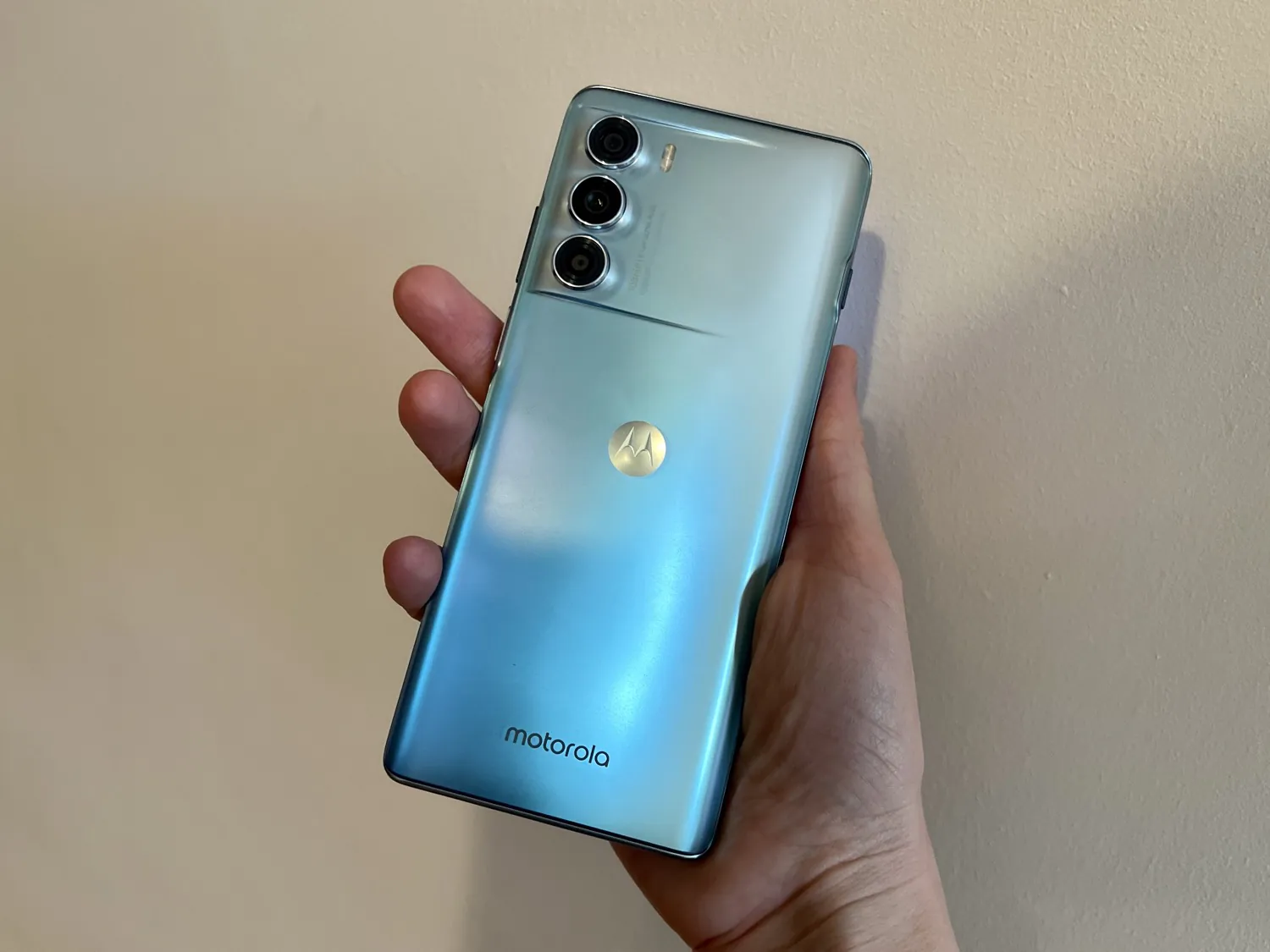
Like its predecessor, the G100, the hero of the review supports the Ready for mode. I also wrote about it in the reviews of Moto Edge 20 and Edge 20 Pro. Ready for is the mode of connecting the phone to a PC or monitor. The device acts as a portable computer and provides a special UI for operation. In the Ready for mode, the phone can be used as an alternative to a computer, a game console, or use its camera and microphone for video conversations. You can connect a wireless mouse, keyboard, or the smartphone itself can be used as a touchpad.
It is worth noting that this mode exists in different variations depending on the model. Some devices support a wired connection method, some only wireless, some (like Edge 20 lite) only the “Ready for PC” option, which allows you to use Ready For in a separate window in a Windows application.
So, the G200 as the flagship received all the features – both wired “Ready for”, and wireless, and “Ready for PC”. The only thing is that unlike the Edge 20 Pro and G100, it has lost a special cable in the kit, so you will have to fork out for it separately (you need USB-C MHL Alt HDMI or USB-C-to-C).
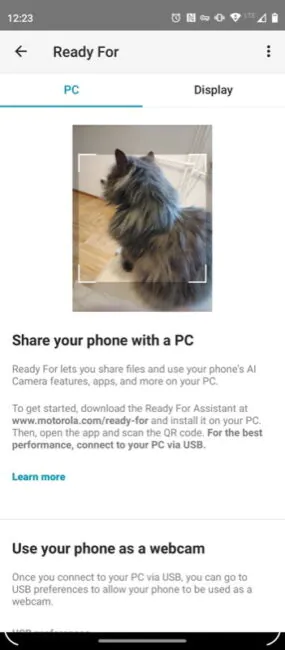
Please understand, but I will not describe the Ready For mode here again, as I have done it more than once. If you want more details, I recommend that you refer to my review of the Moto Edge 20 Pro, where the PC connection modes are described in detail.
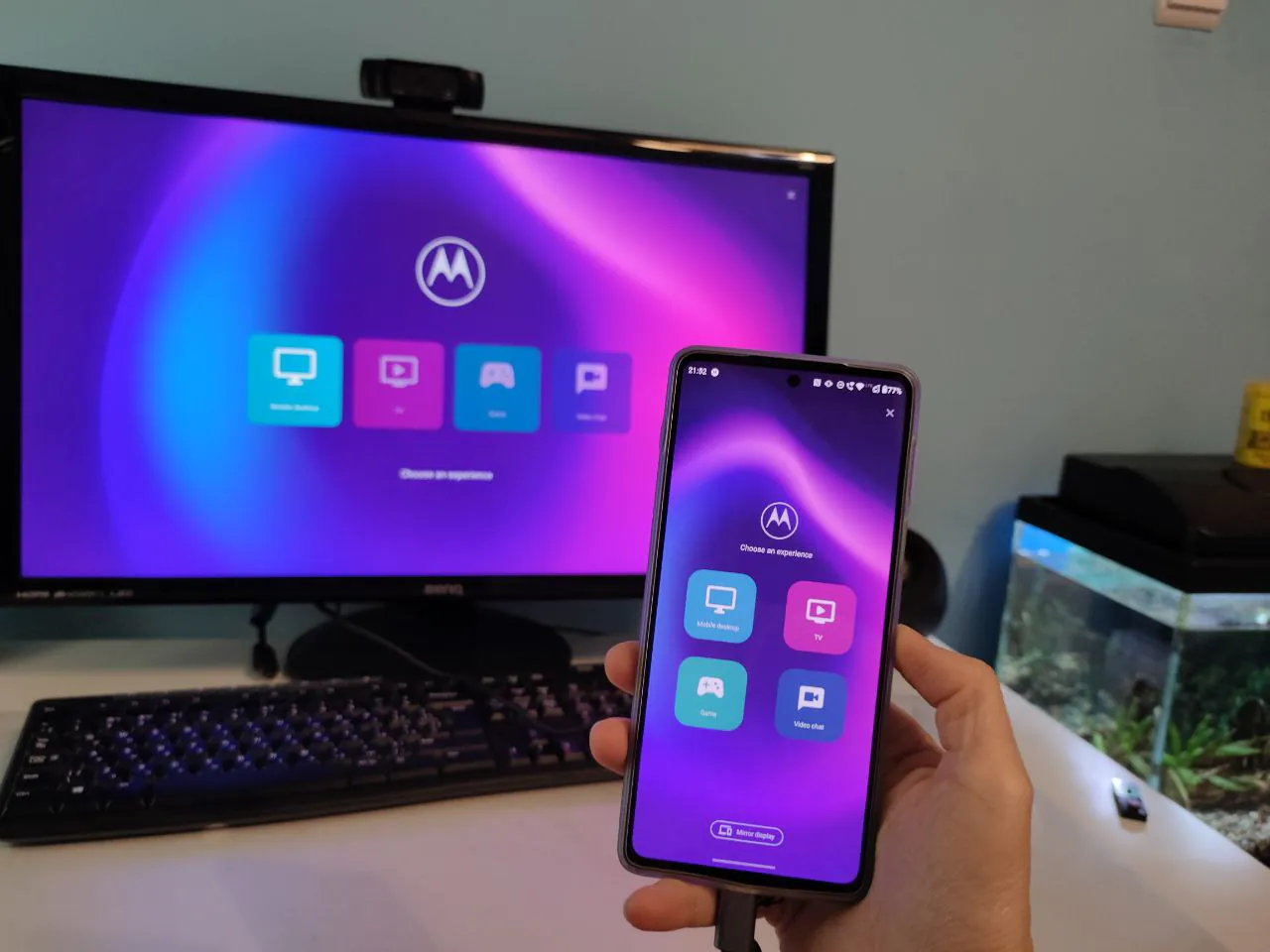
To sum up, Ready For is an interesting feature. It is rarely found in smartphones and especially in mid-range models. Samsung Dex is its only alternative, but it’s available only in flagships. At the same time, the function is implemented well. There were no problems during the test, excluding not the most convenient touch control.
Read also: Motorola Moto G60s review — Big budget phone with super fast charging
Sound
The main speaker is monophonic. It’s a pity that Motorola has saved money here, most competitors have stereo speakers. The speaker itself is loud enough. In headphones, too, everything is OK, just keep in mind that there is no 3.5 mm jack.
Previously, Moto G smartphones had a built-in equalizer, but now it has been replaced by Dolby Atmos modes. Moreover, there are more of these modes in the G200 than in other new products of the G series – music, cinema, game, podcast. And by default, the phone itself determines the nature of the audio and adjusts the sound.
There is also a SI CrystalTalk function in the sound settings, which improves voice transmission during telephone conversations.
Software
The Motorola G200 runs on Android 11. Version 12 update has been promised, but it is still unclear when exactly it will arrive. Probably in February. An update to Android 13 will also come in due course.
The traditional advantage of Moto is a nimble clean Android without any shells. Only its own launcher is used, but it does not differ significantly from the usual Android.
And there is also a whole app called Moto Functions with a collection of useful settings – themes, gesture control (for example, turning on the flashlight by double shaking the phone, activating the camera by rotatinh the wrist, screenshot by touching the screen with three fingers, silent mode by turning the smartphone screen down, etc.) and other features (active display, the ability to run applications in a separate window during gameplay and other tweaks for gamers).
There is an analog of AoD – time and notifications on the lock screen with the ability to quickly preview them with a touch (Peek Display). This screen activates itself if you take the device in hand.
Battery life
Moto G200 received the “classic” battery for the G-series — 5000 mAh. With such a smartphone, you can enjoy all activities for at least a full day. During the test, I charged the device every 1.5-2 days.

You can surf the Internet or watch YouTube videos for 8-9 hours without a break. It takes about 4-5 hours of a “heavy” 3D to lose charge. And this is at maximum brightness and with an adaptive screen refresh mode of 60/144 Hz.
33-watt fast charging is supported. Of course, this is not a record by current standards, but it takes an adequate 1 hour and 10 minutes to fully charge. There is no wireless charging.
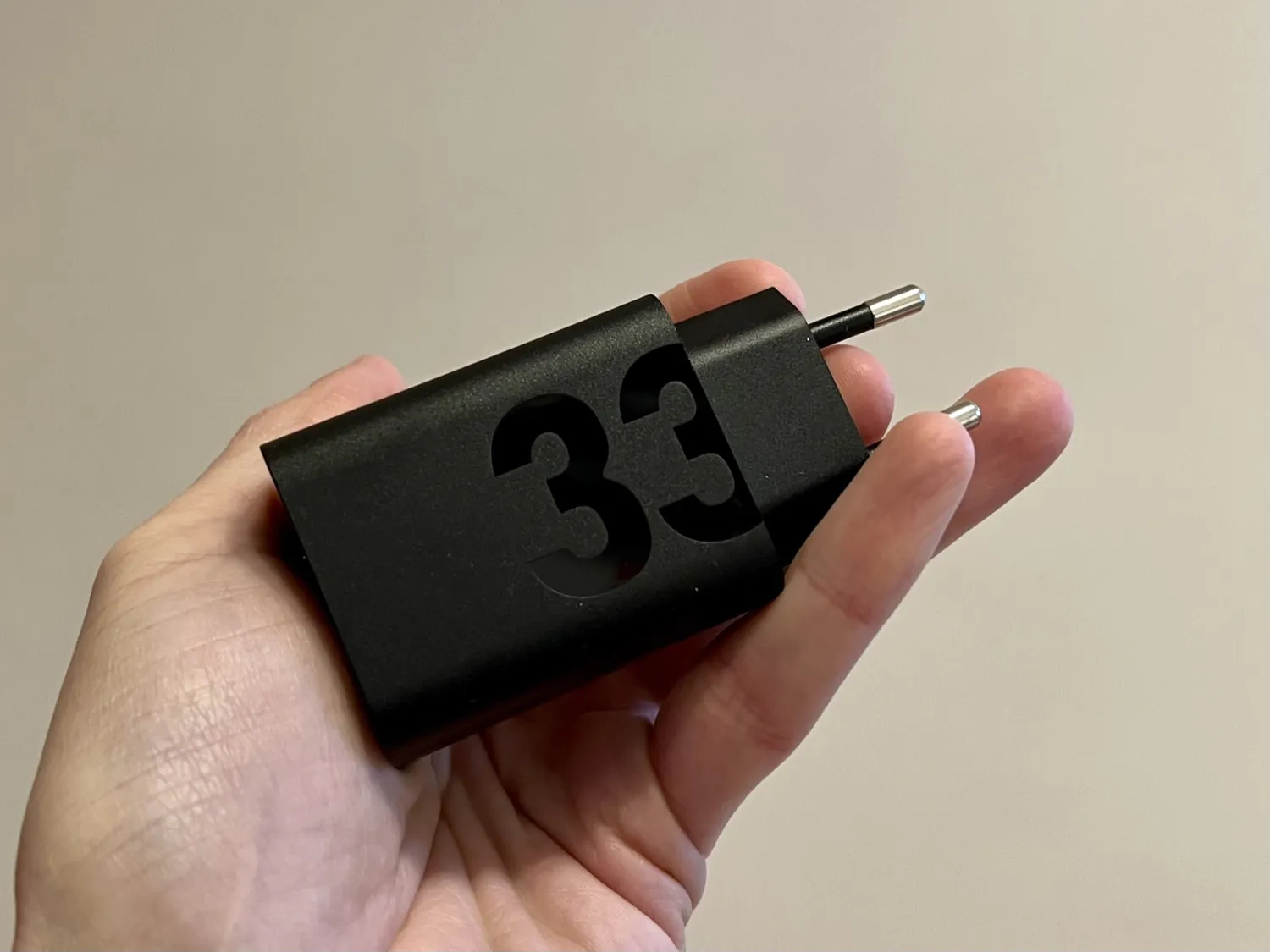
Read also:
- TECNO CAMON 18 Premier review: Gimbal stabilizer and 5x zoom in a mid-ranger?
- Samsung Galaxy S21 FE 5G review: Now definitely a fan flagship
- Huawei nova 9 review: phone that could have been a hit
Verdict
The new flagship G-series from Moto turned out to be more interesting than last year’s G100. With its fresh approach to design, an neat back panel and camera unit, a top-end Snapdragon 888+ processor, a smooth display with a refresh rate of 144 Hz, it’s quite an interesting device. At quite an affordable price. The battery is great. Cameras may not be the best, but they aren’t bad considering the cost. There’s also the Ready For mode that’s quite impressive in its own right.
Of course, there are also things that the manufacturer has saved on. IPS screens are less impressive than OLED, although the opponents of the PWM might disagree. The mono speaker is not serious at all. There’s no memory card slot , which is also a shame. The Ready For mode is available in the wired version, but there’s no cable in the box. The cameras could be a little better, especially when shooting in low light. There is not enough optical stabilization, the images are often blurred.
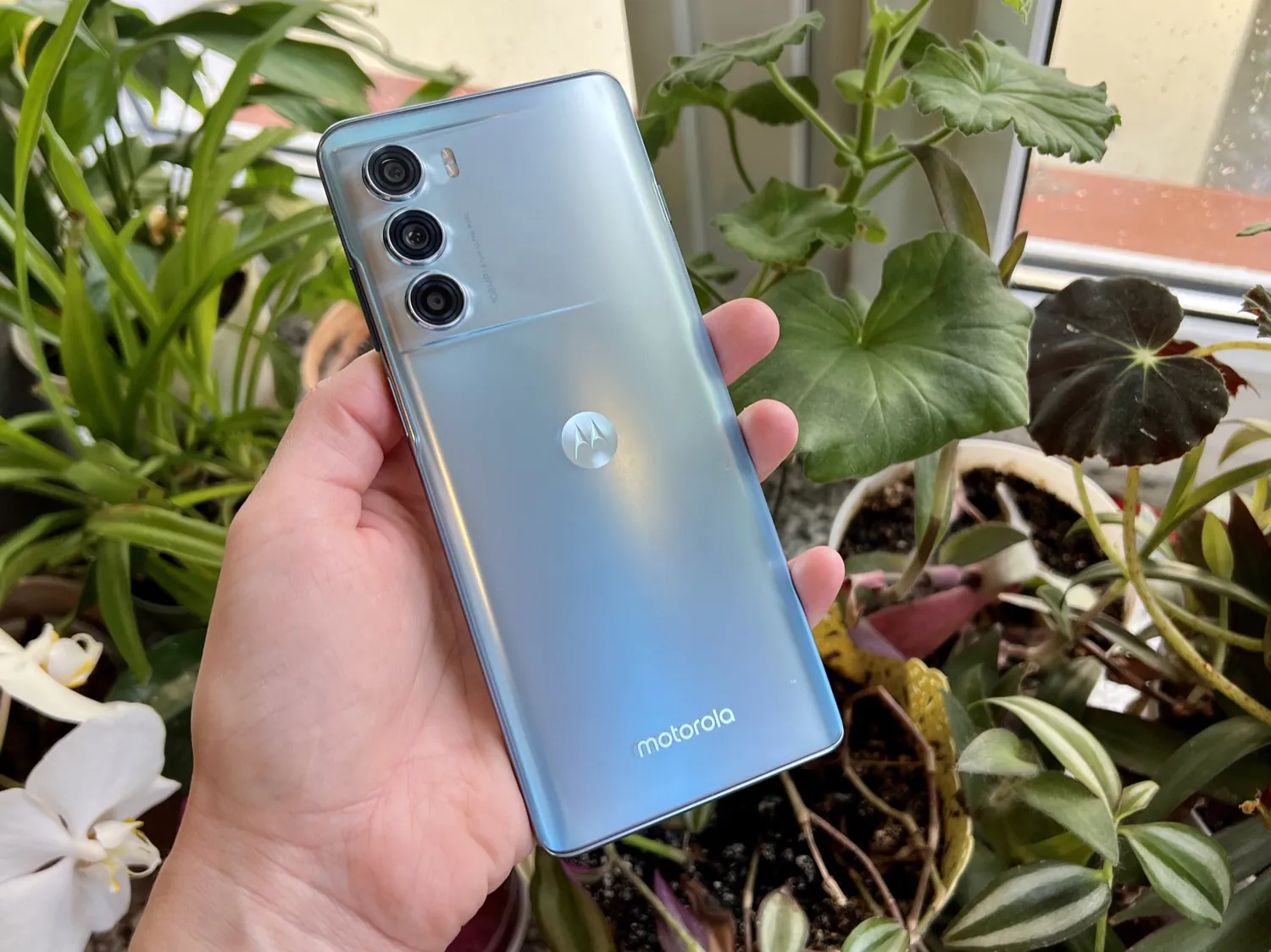
As you and I know, there are no perfect devices in any price category. For me personally, the disadvantages of the G200 are not critical, but a nimble chipset makes all the difference. In addition, you get great build quality, clean, well-optimized Android without shells, glitches and unnecessary applications, with minimal Moto additions, and regular security updates. The G200 is sure to find its fans.
And, as you know, I don’t let go of any phone from my review without listing competitors.
And here it is worth saying that Motorola has released (and this does not always happen) a successful, balanced model in terms of price and characteristics. Among the competitors, we note, for example, the Samsung Galaxy S20 FE SM-G780G that costs about the same, but has only 6 GB of RAM and a smaller 4500 mAh battery. The chipset is the Snapdragon 865. Among the advantages are a Super AMOLED 2X 120 Hz screen, stereo speakers, full IP68 protection, a memory card slot. Our review of the S20 FE is available at this link.
The POCO F3 is a popular hit from Xiaomi which costs less than G200. It received 8 GB of RAM and 256 GB of storage (the G200 has 128 GB), an AMOLED display with 120 Hz, Dolby Atmos stereo speakers, and a 4520 mAh battery. The processor, though productive, is still weaker (Snapdragon 870).
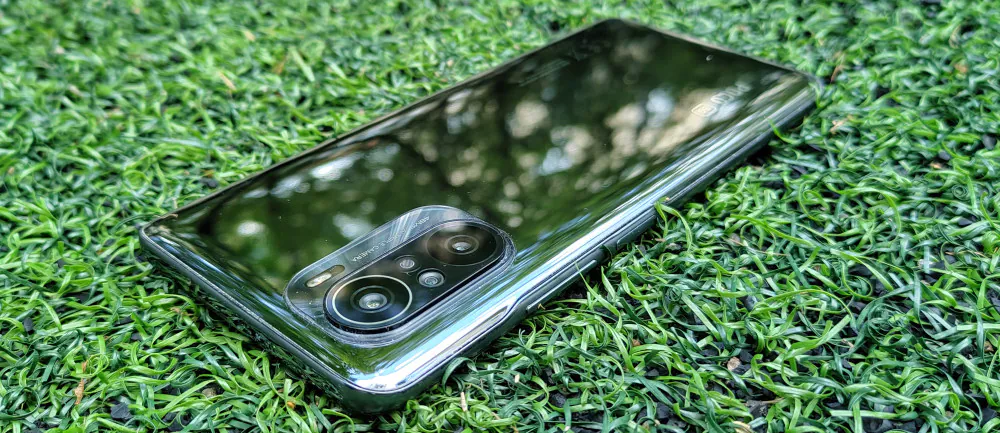
Don’t forget the Xiaomi 11T 5G, which can be cheaper than the G200 (depends on the country). This is a fresh “almost flagship” with an AMOLED 120 Hz display, a 108 MP main camera (in my opinion, the photo quality is high considering the cost), a 5000 mAh battery with support for fast 67 W charging, and Dolby Atmos stereo speakers. The processor is a top-end MediaTekDimensity 1200 Ultra, but MTK is still not Snapdragon, it is less optimized, in particular, for games. In any case, the option is interesting, but Moto has its advantages, including a clean Android. You can read the review of the Xiaomi 11T on our website.
An interesting option may be the realme GT Neo 2, which is also slightly cheaper than the G200. A smartphone with 12/256 GB of memory received an AMOLED screen of 120 Hz, a 5000 mAh battery with 65 watts charging. There are, of course, stereo speakers. However, this is not an option for those who want the most advanced processor, since Snapdragon 870 is installed here.
Read also: Realme GT Neo 2 review: Almost a flagship killer
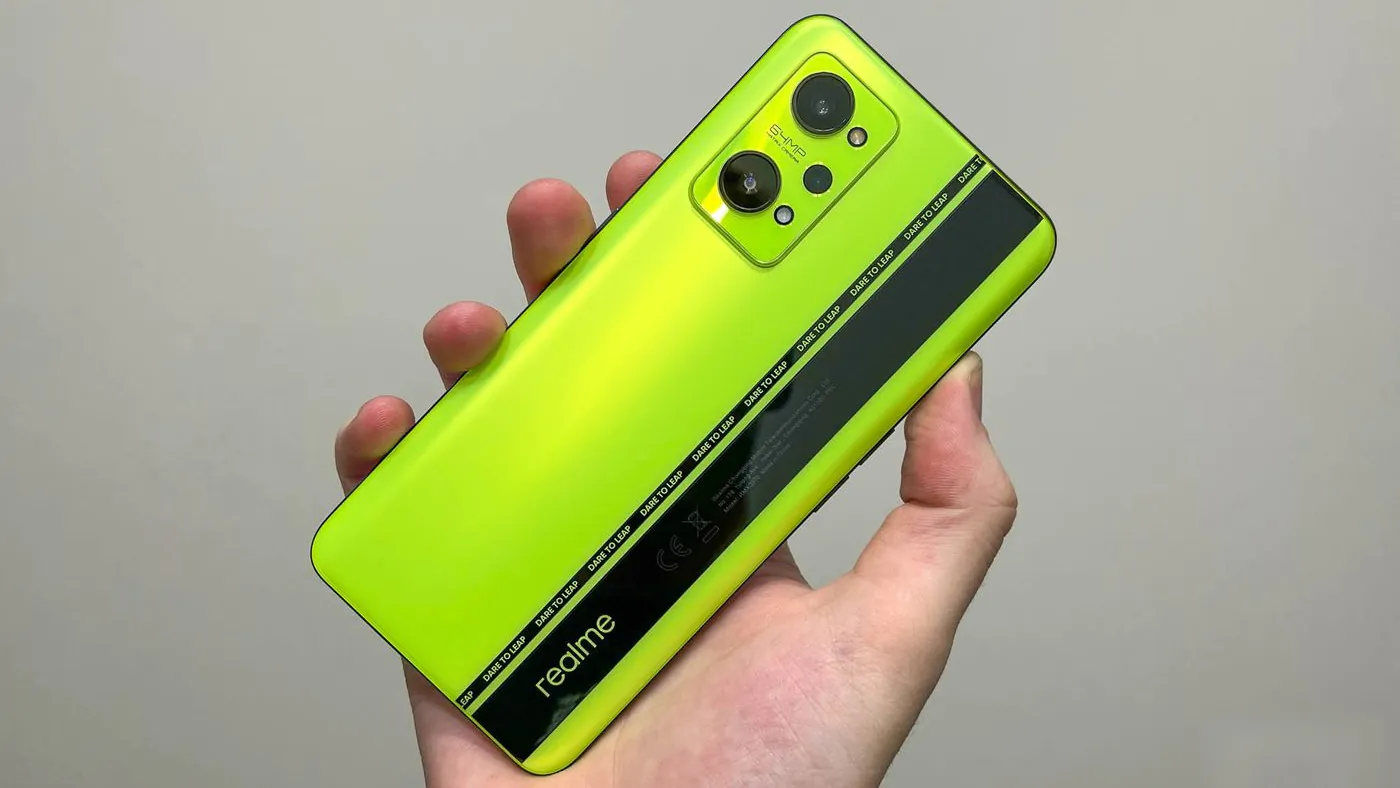
Finally, I will note the realme GT 8/128 GB, which became a hit in 2021. This is the only device in the list of competitors based on Snapdragon 888, but the first generation, still without a plus sign like the G200. The device has an AMOLED 120 Hz display and stereo speakers. However, the 4500 mAh battery is not very impressive, although there’s a a 65W charger, the software is unpolished, the cameras are sorta weak. Often this smartphone is sold out everywhere, but at the moment it is available in stores without discounts and costs like the Moto G200.
To sum up: there are competitors, but if you focus on a top-end chipset, a decent 108 MP main camera and Android without shells, then the Moto G200 still has no strong alternatives. Especially for the money it costs.
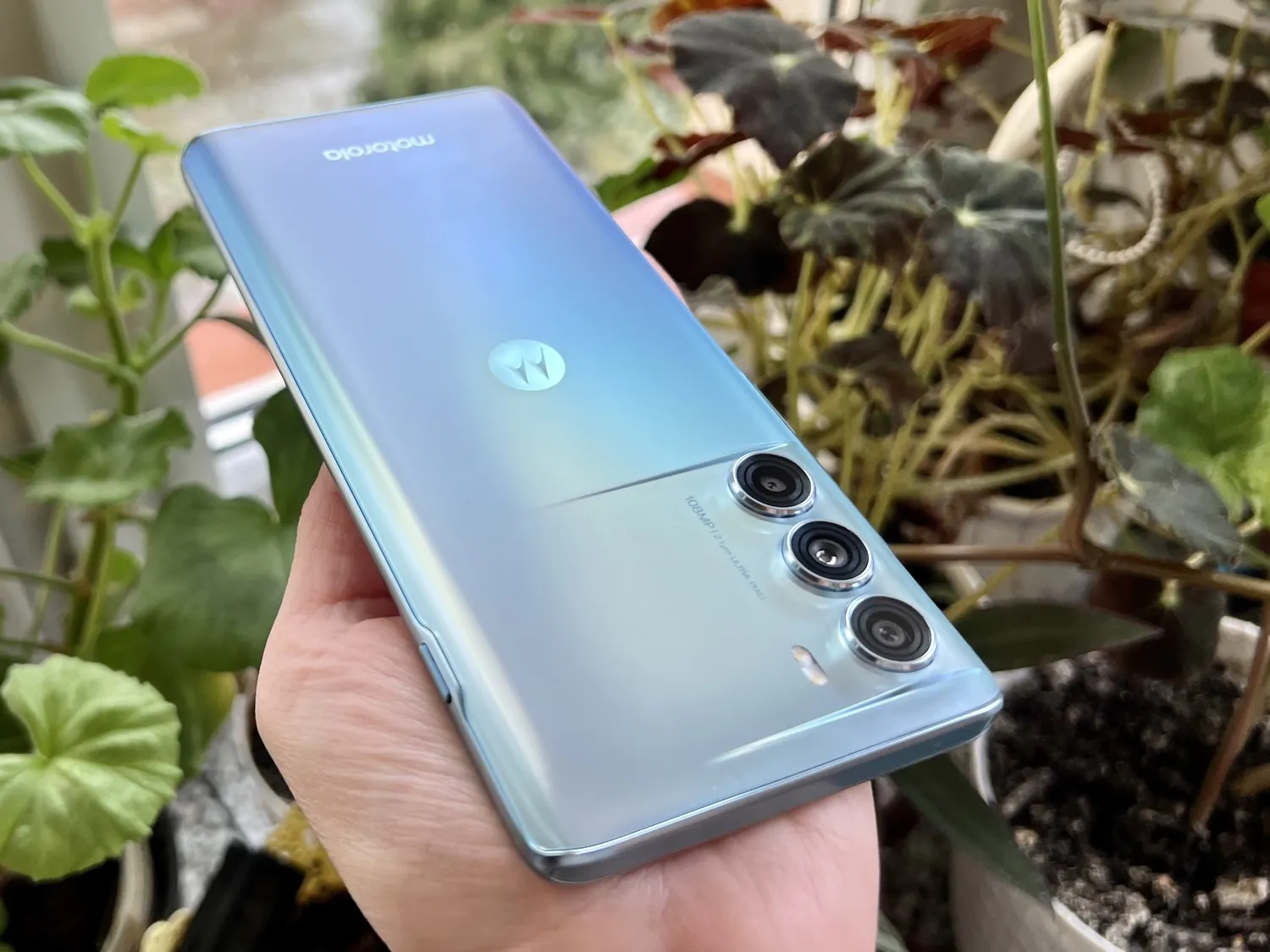
And what do you think about the model?

Where to buy
- Amazon


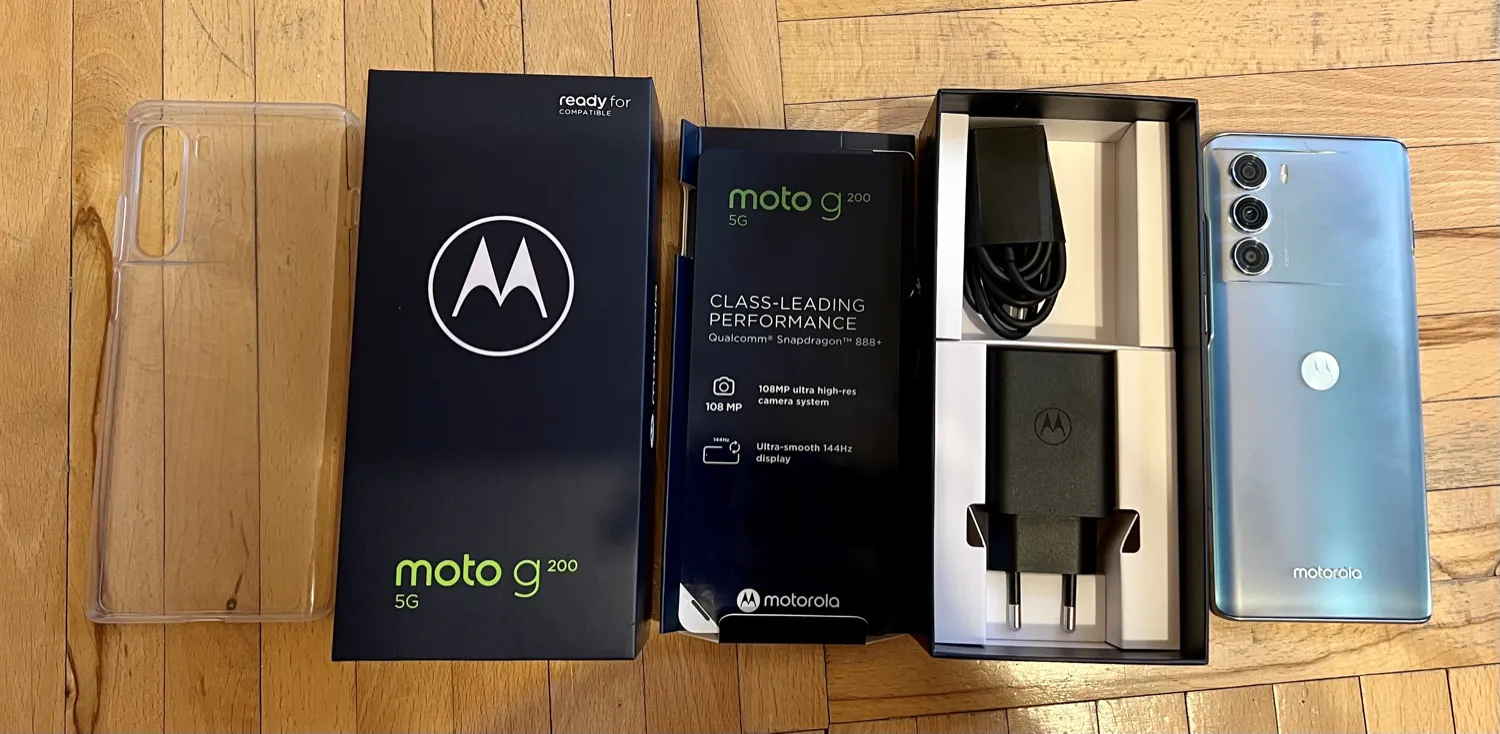

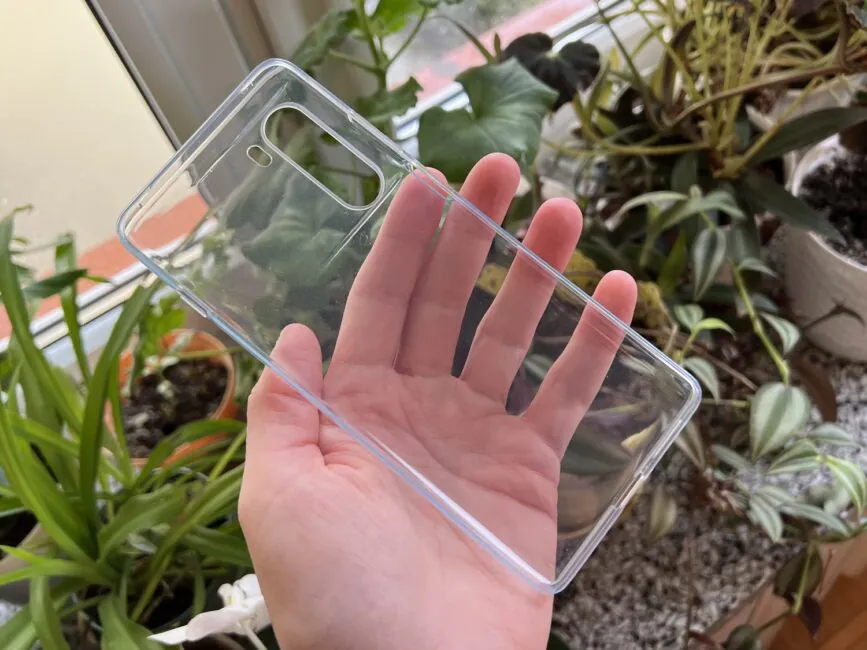
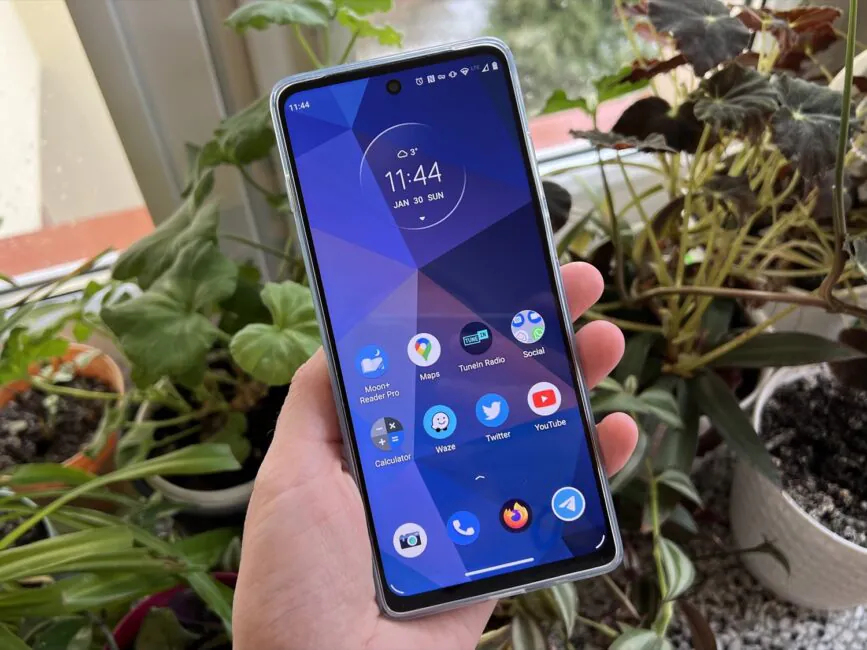
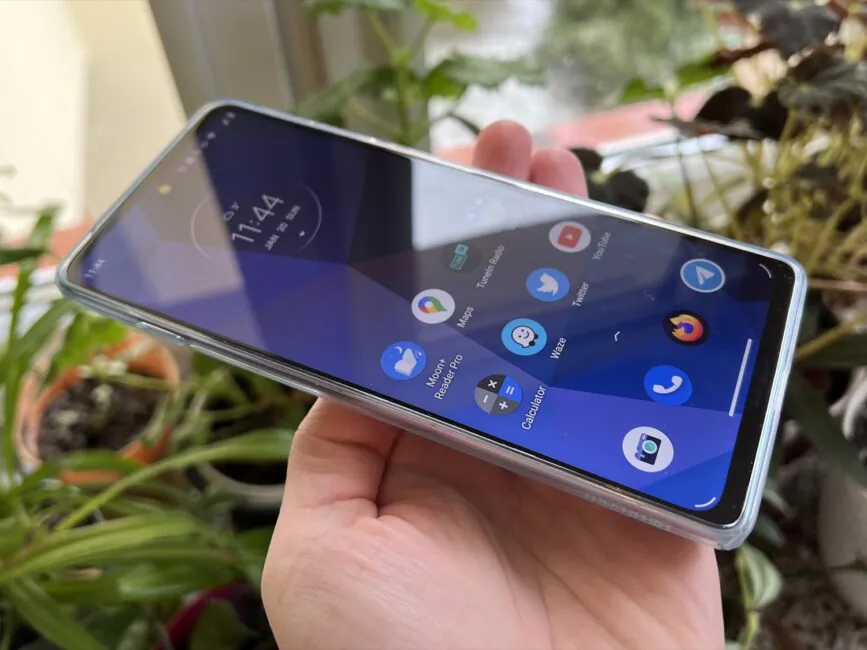
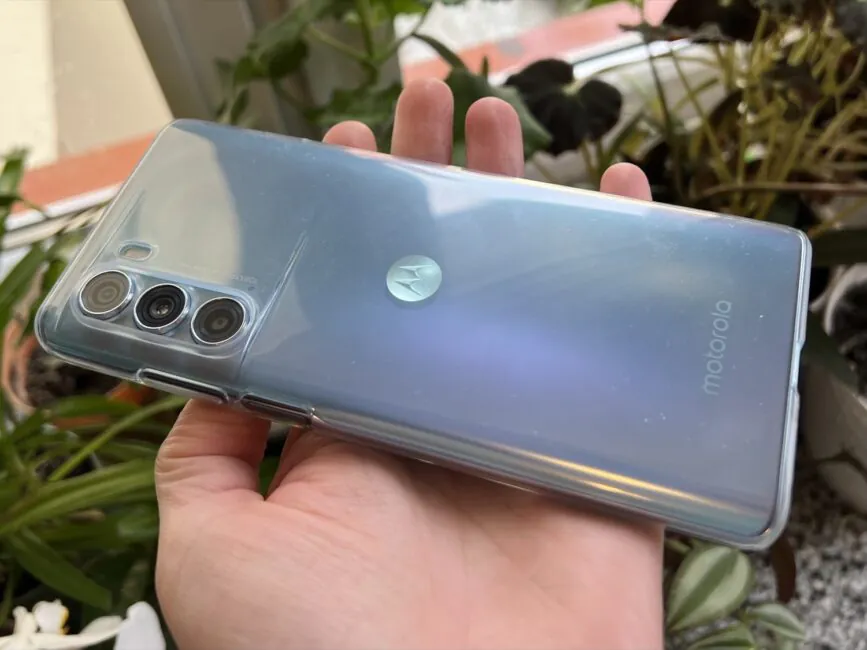
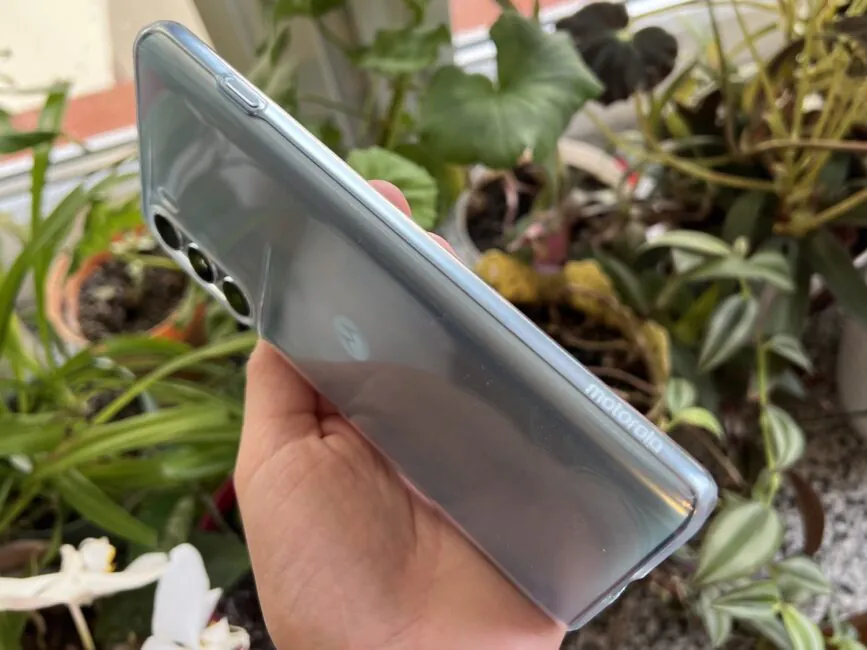
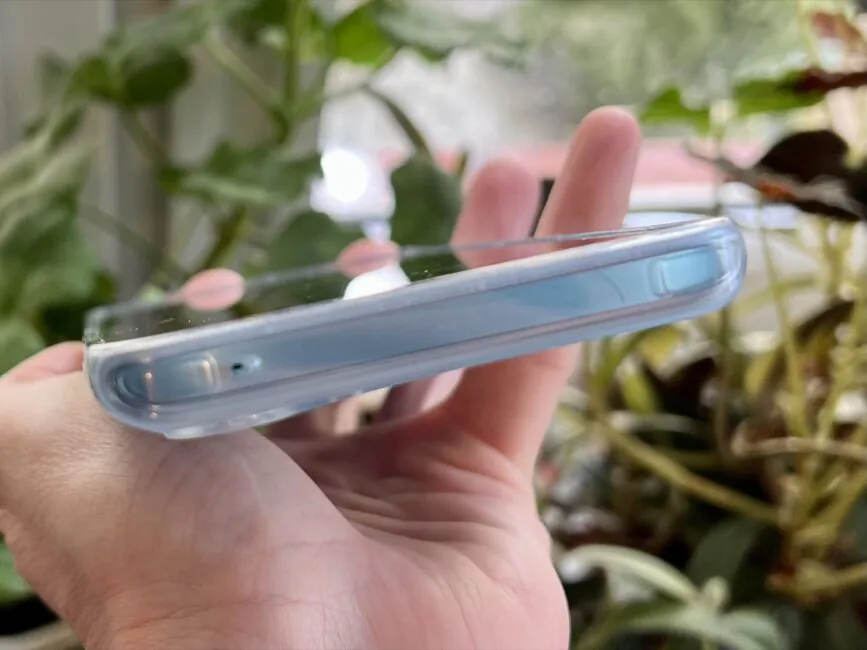
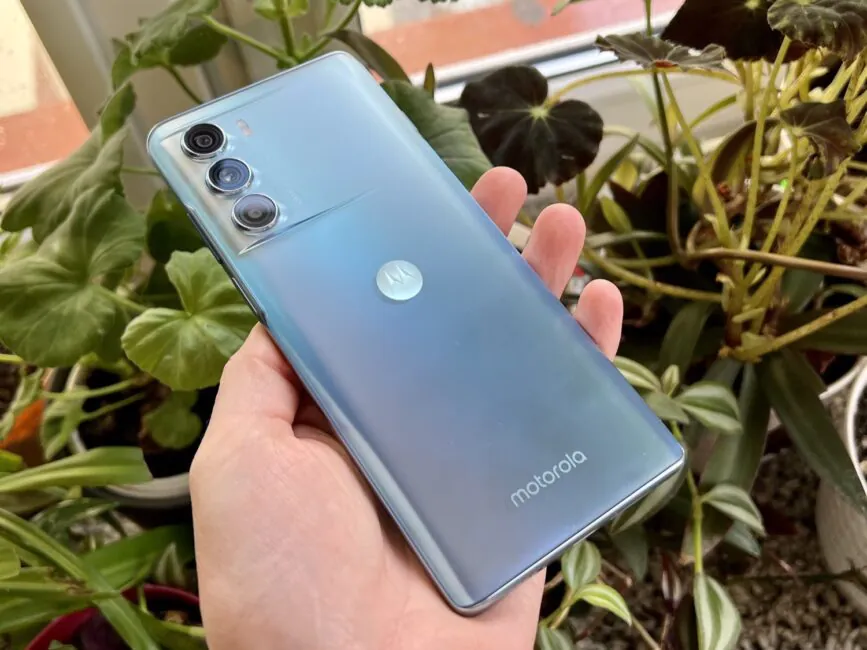
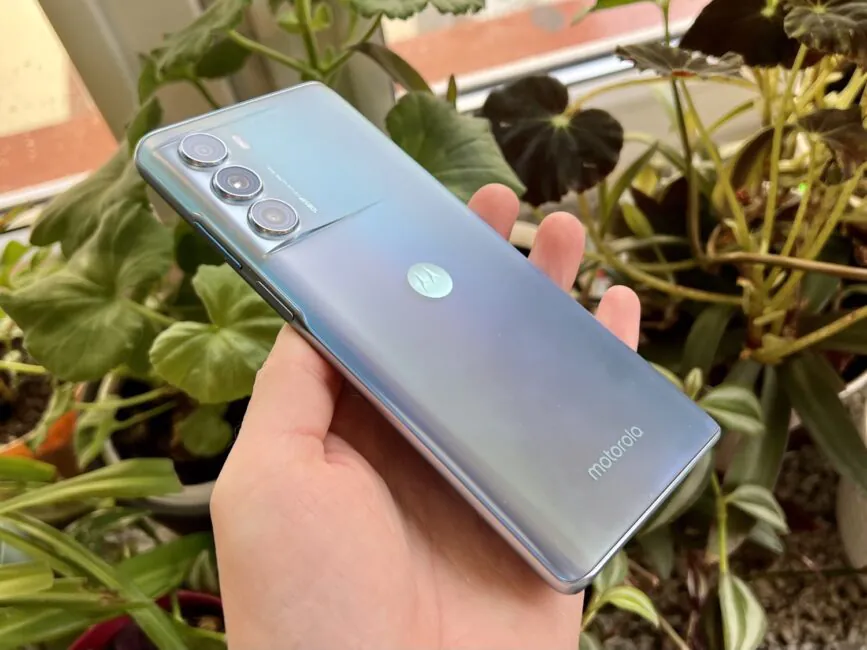
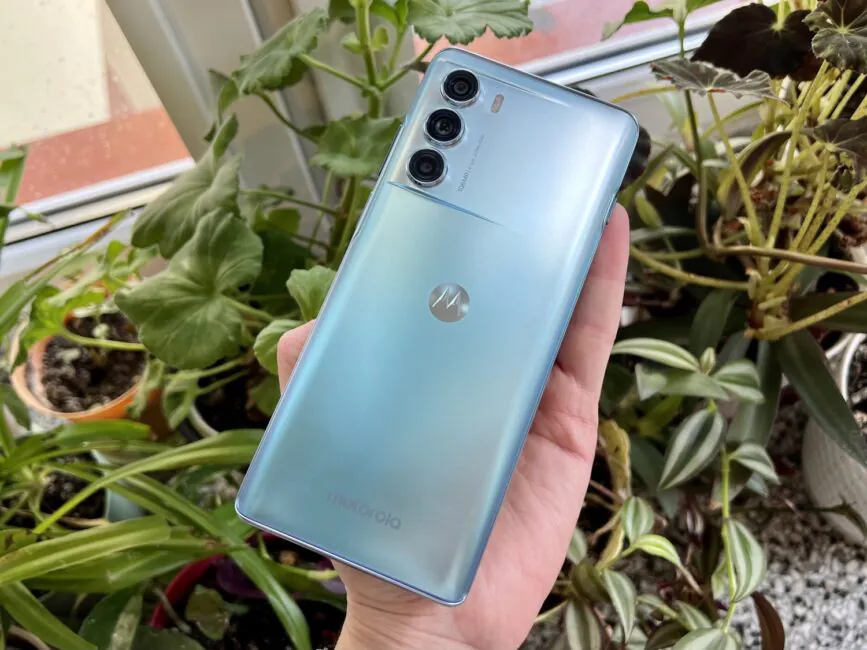
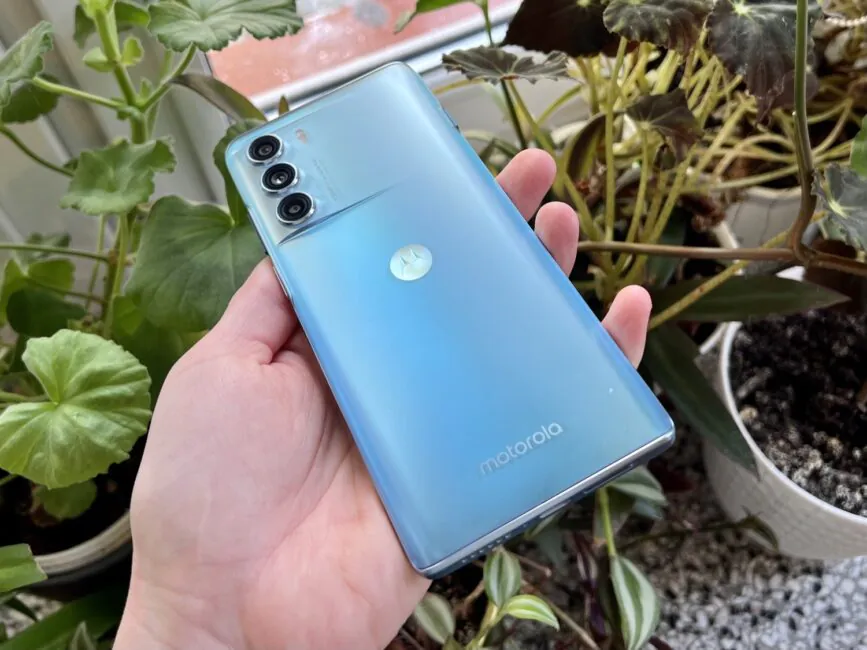

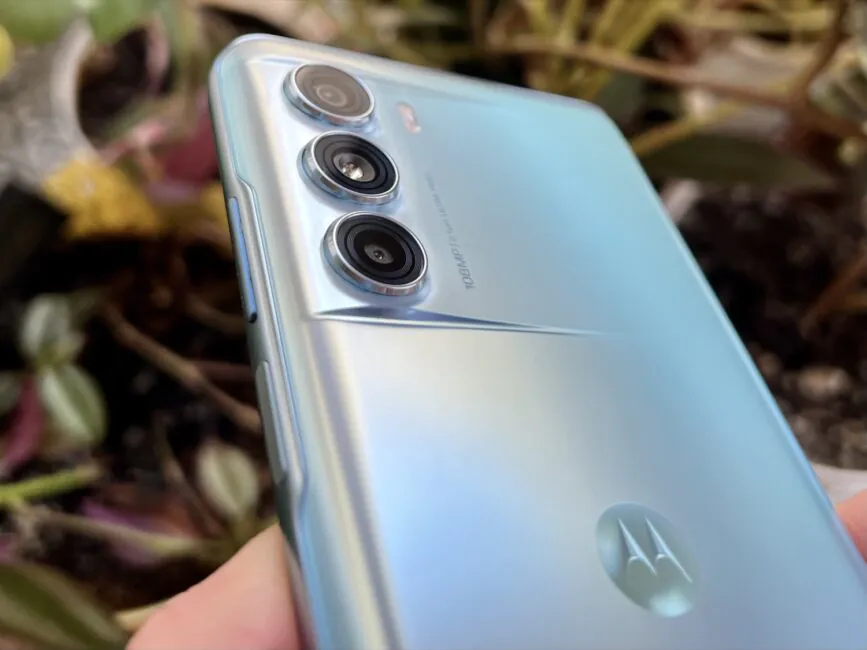
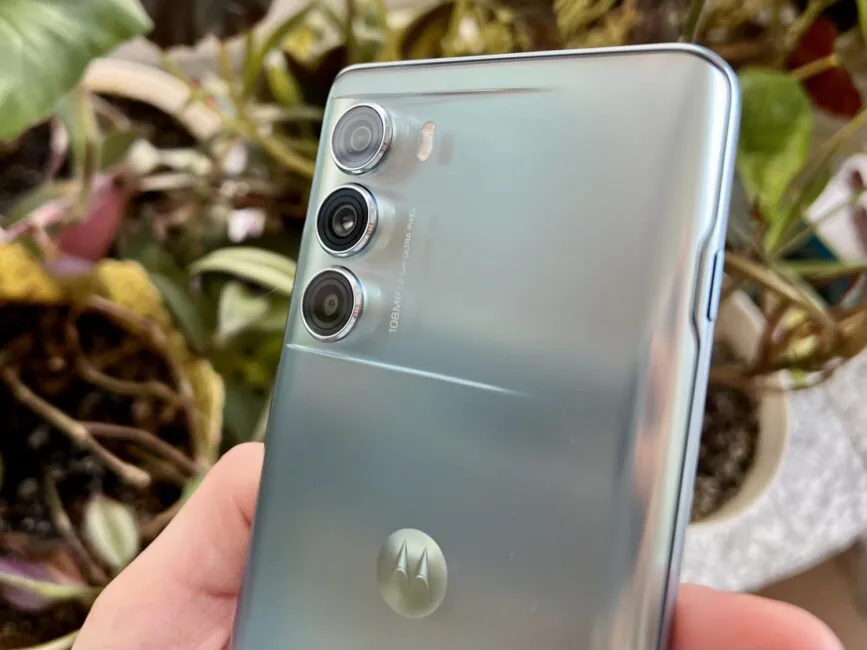
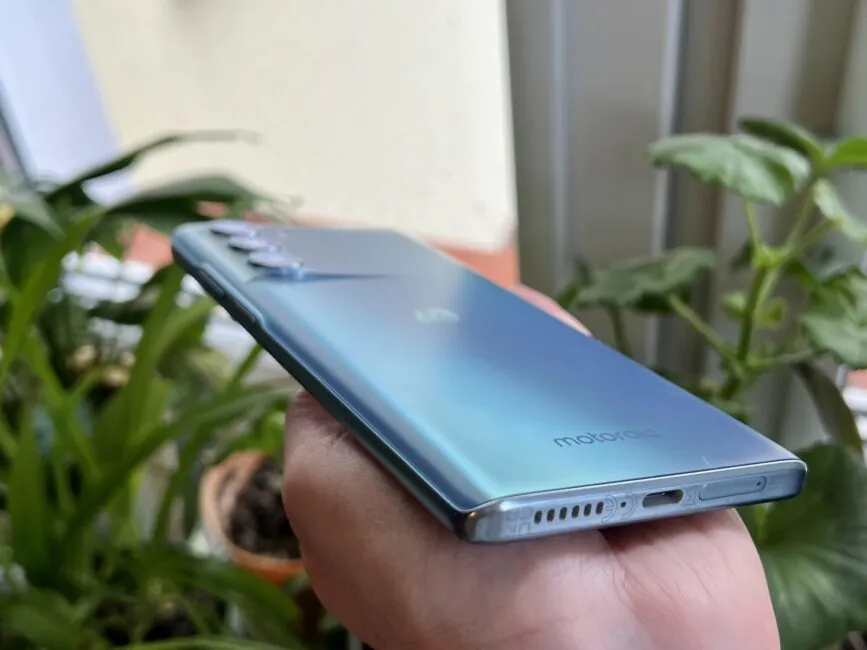
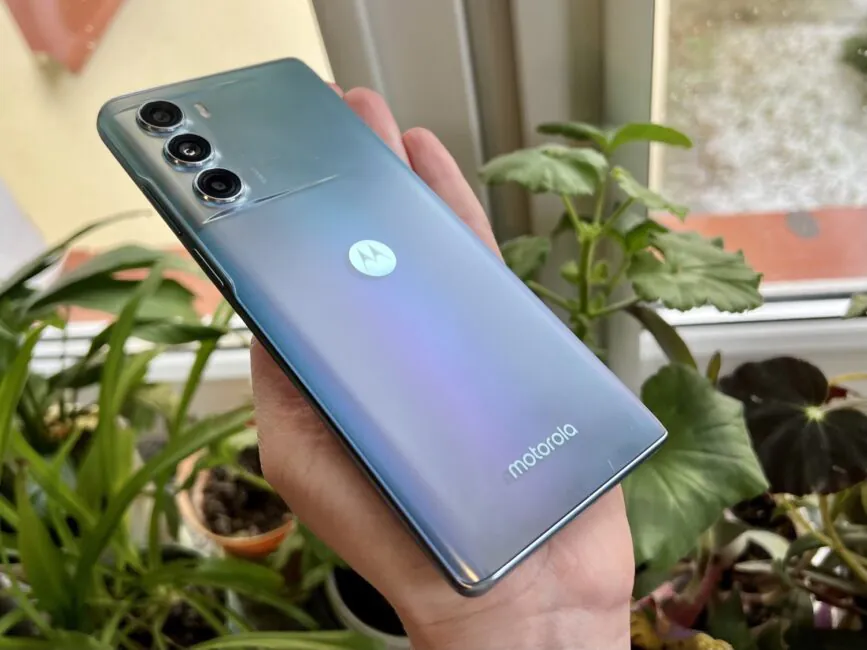
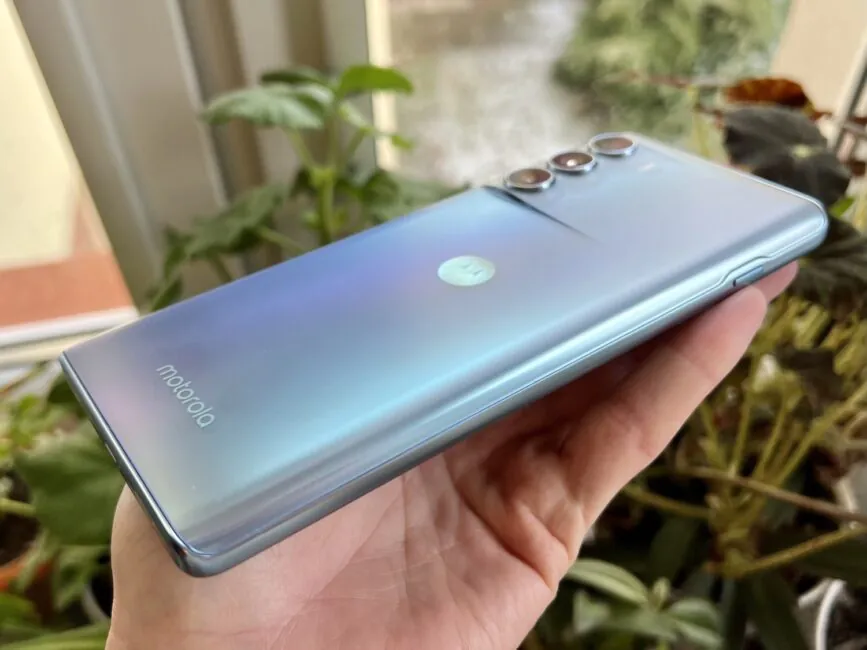
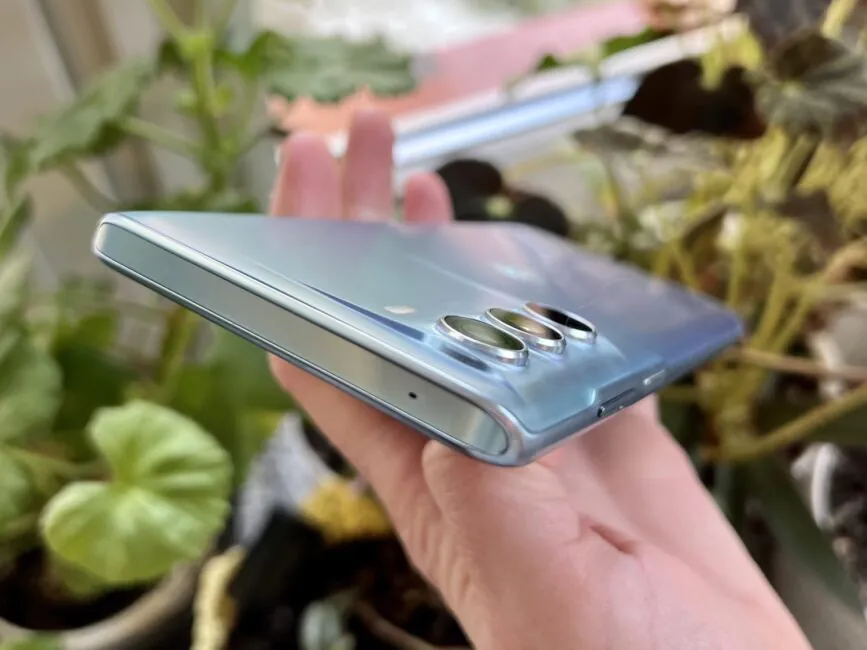
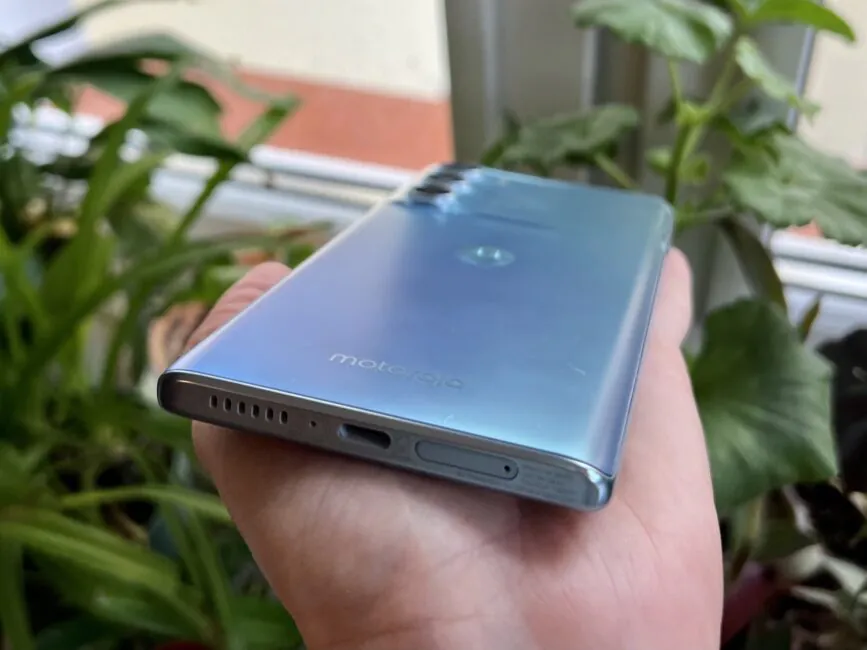
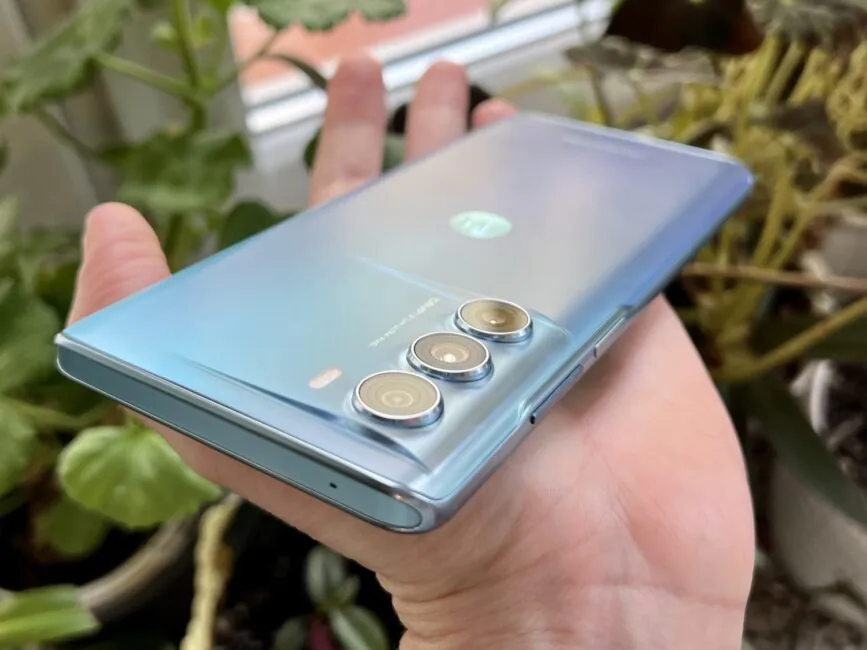
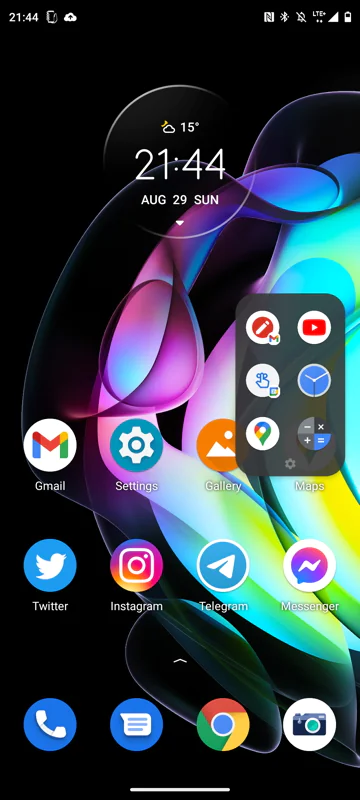
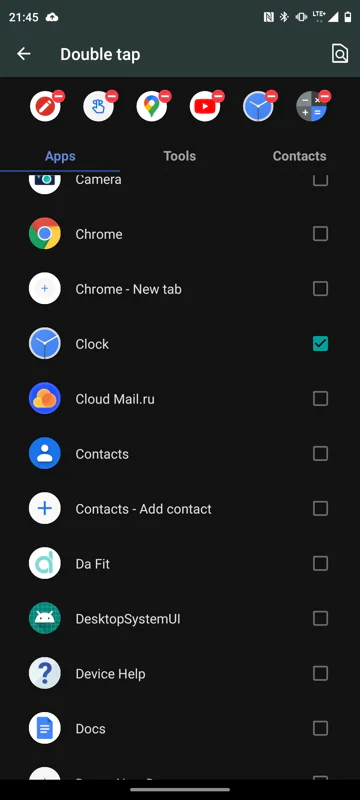



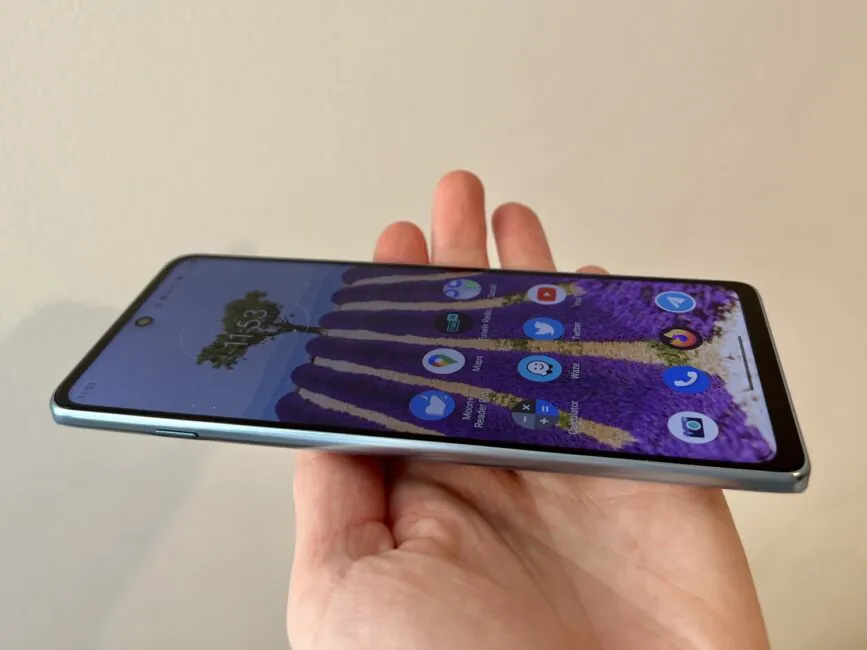
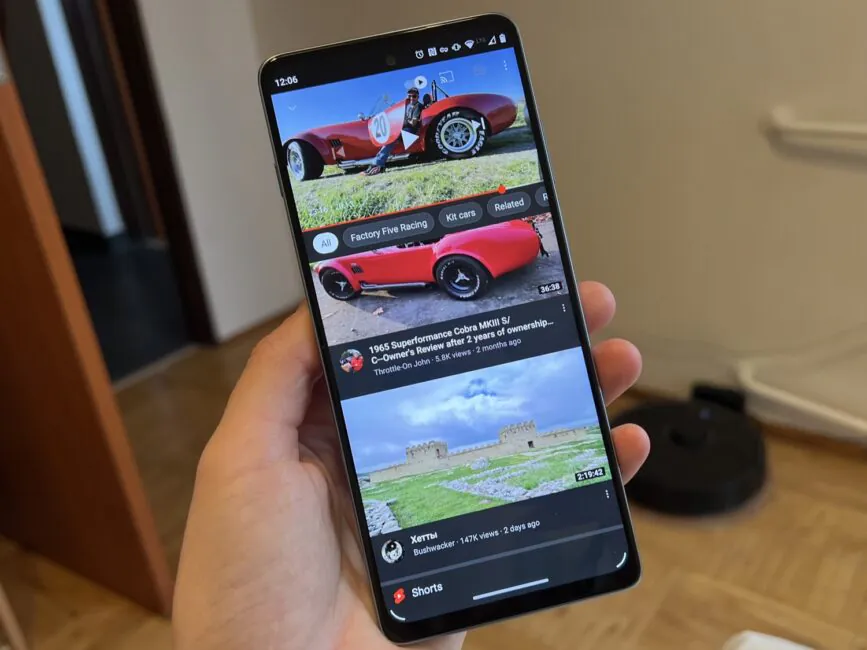
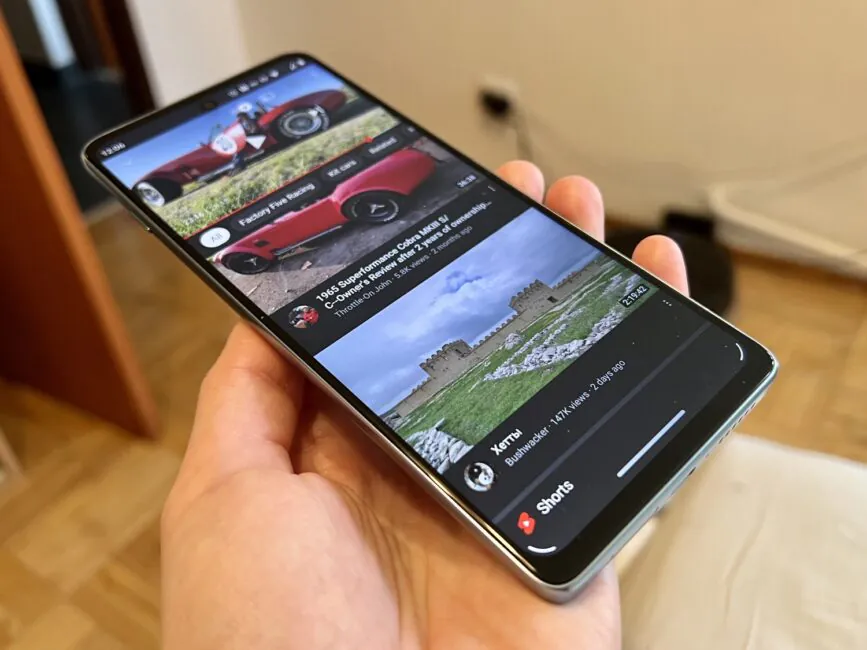
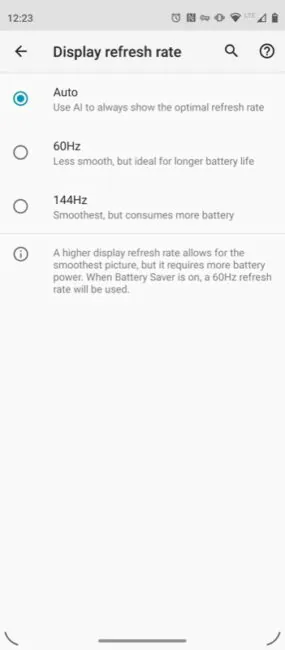
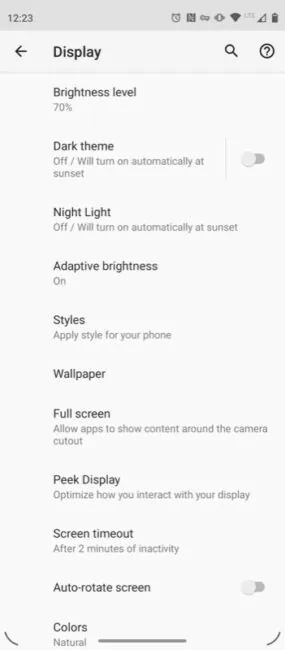
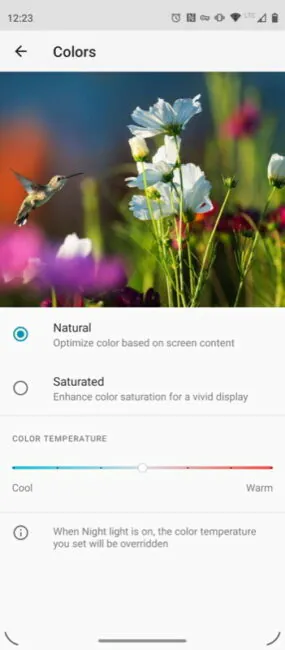
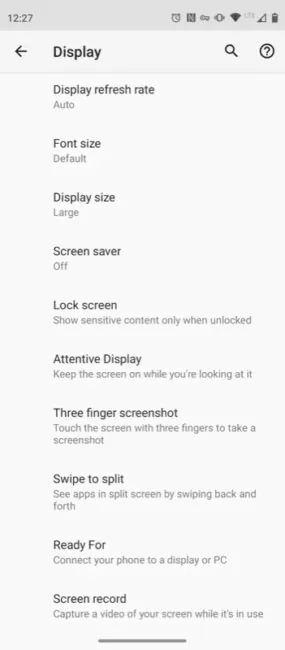
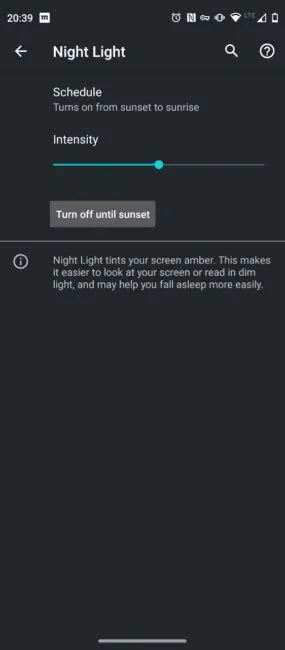
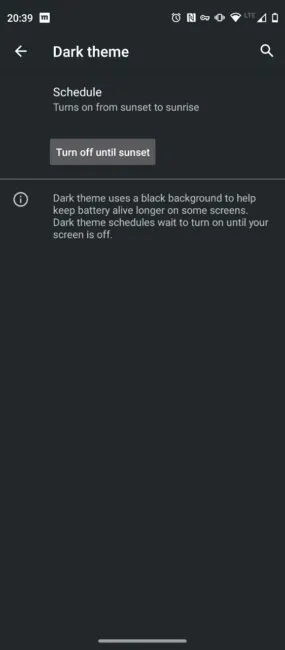





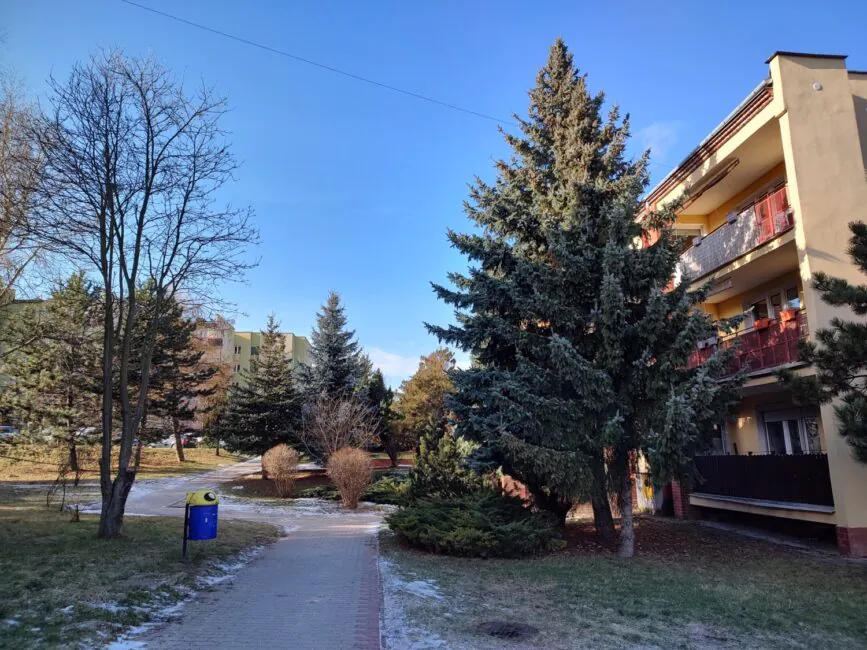
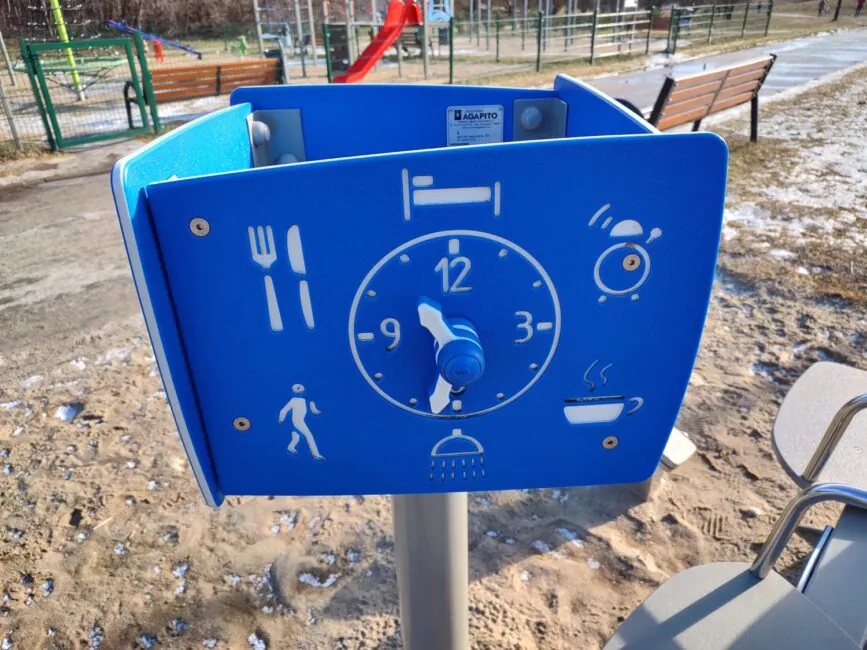








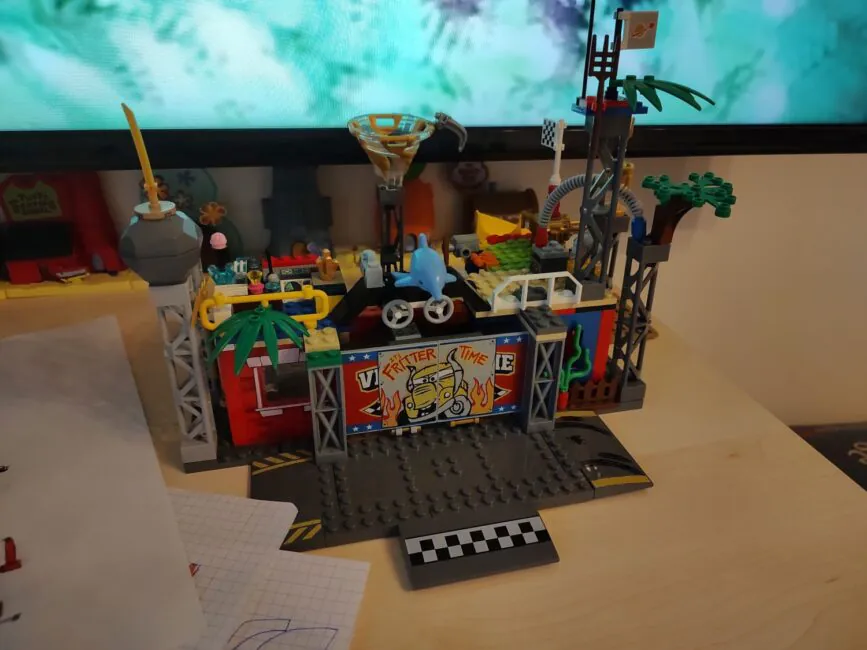











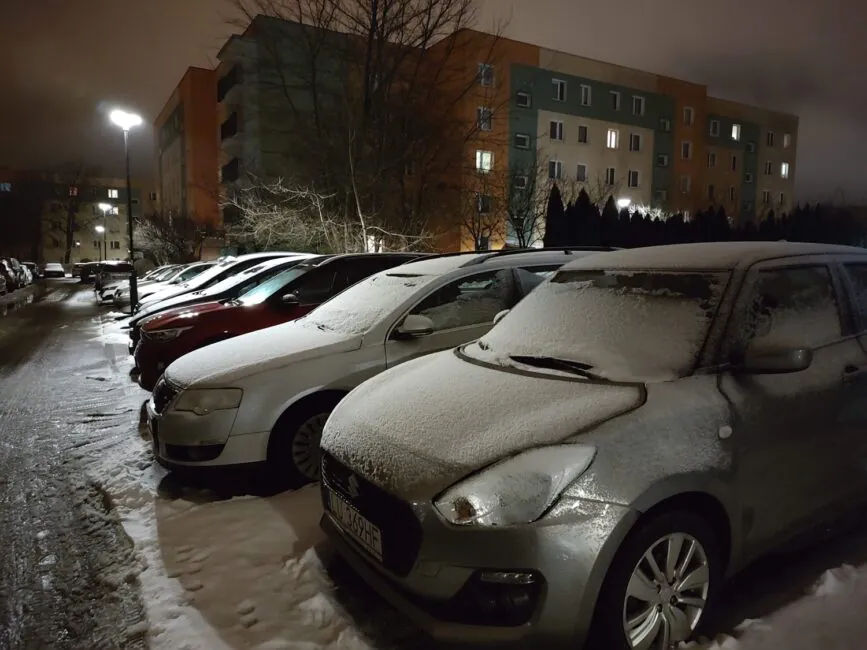


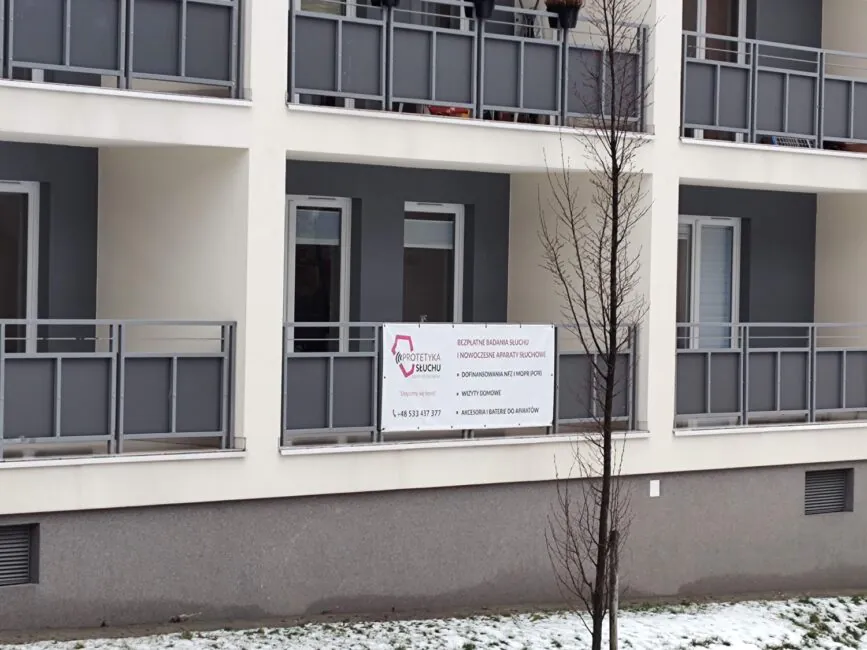
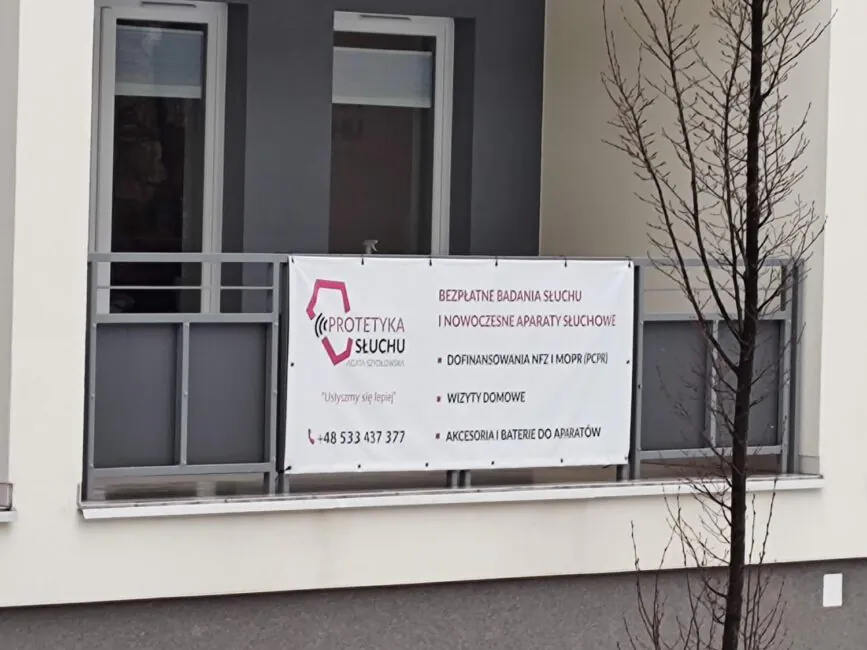






















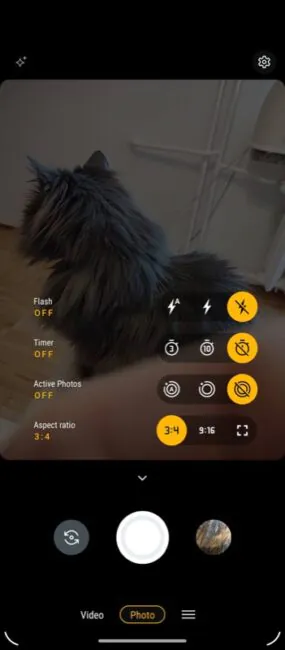
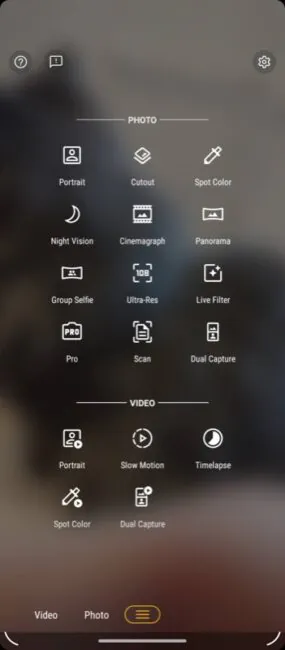
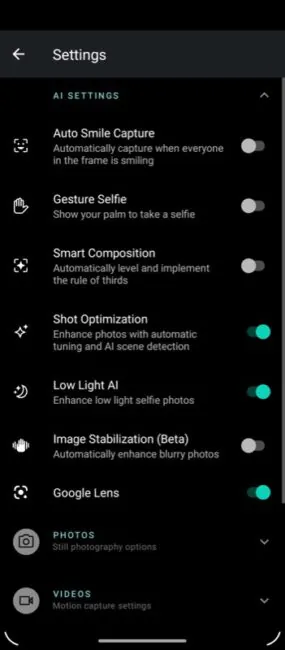
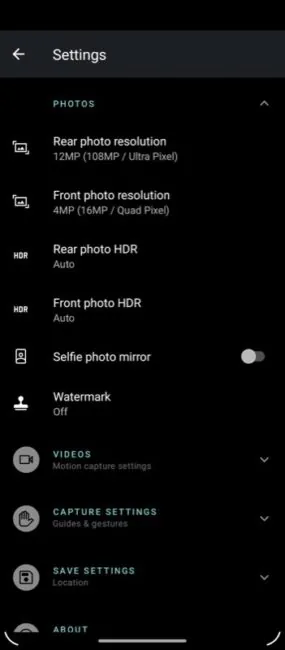
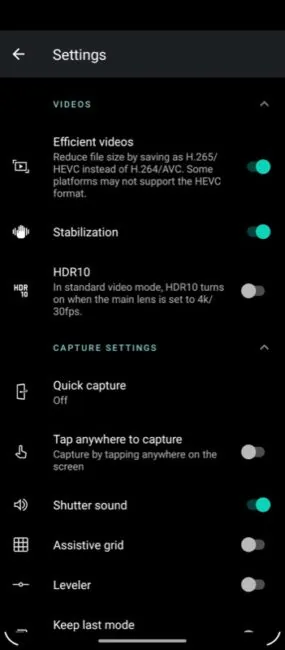
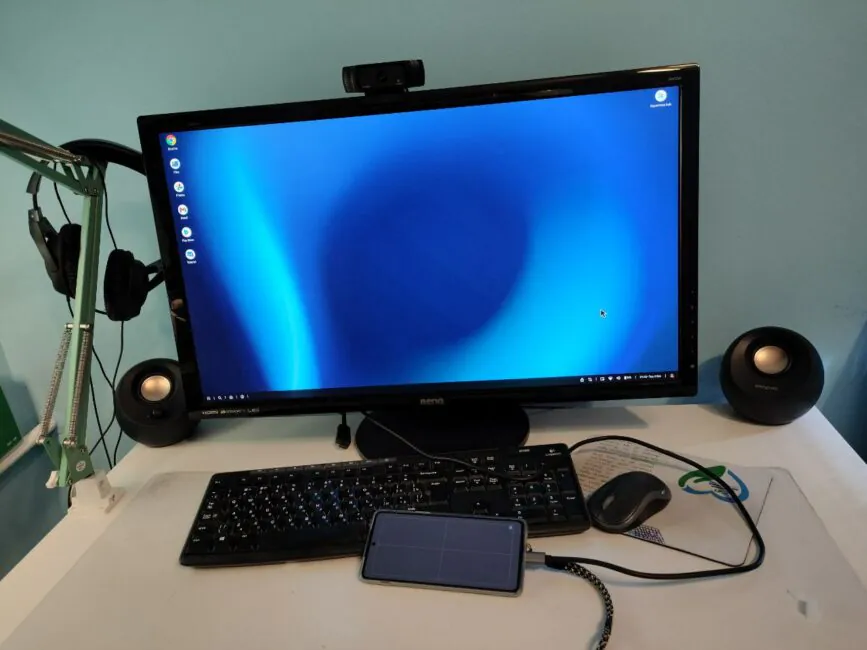
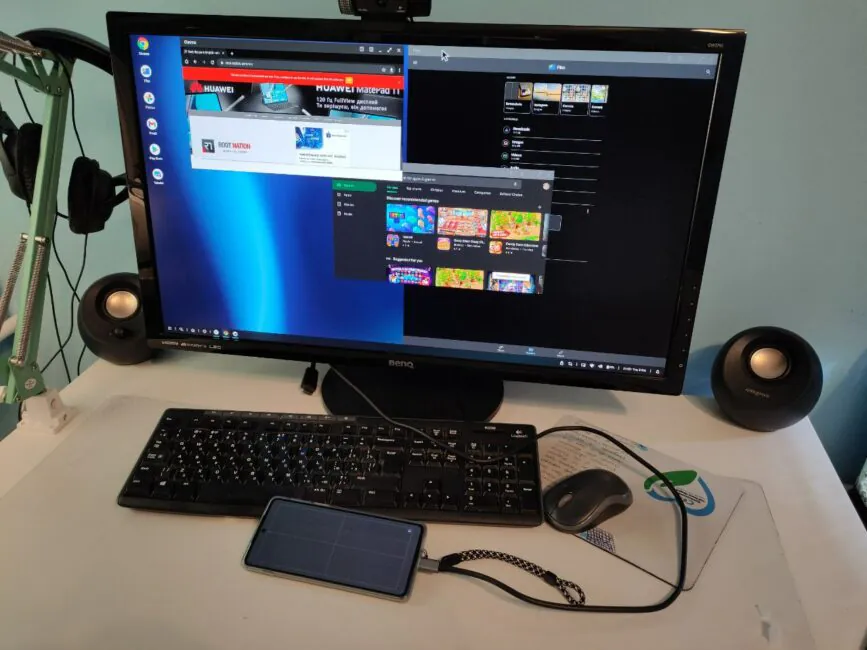
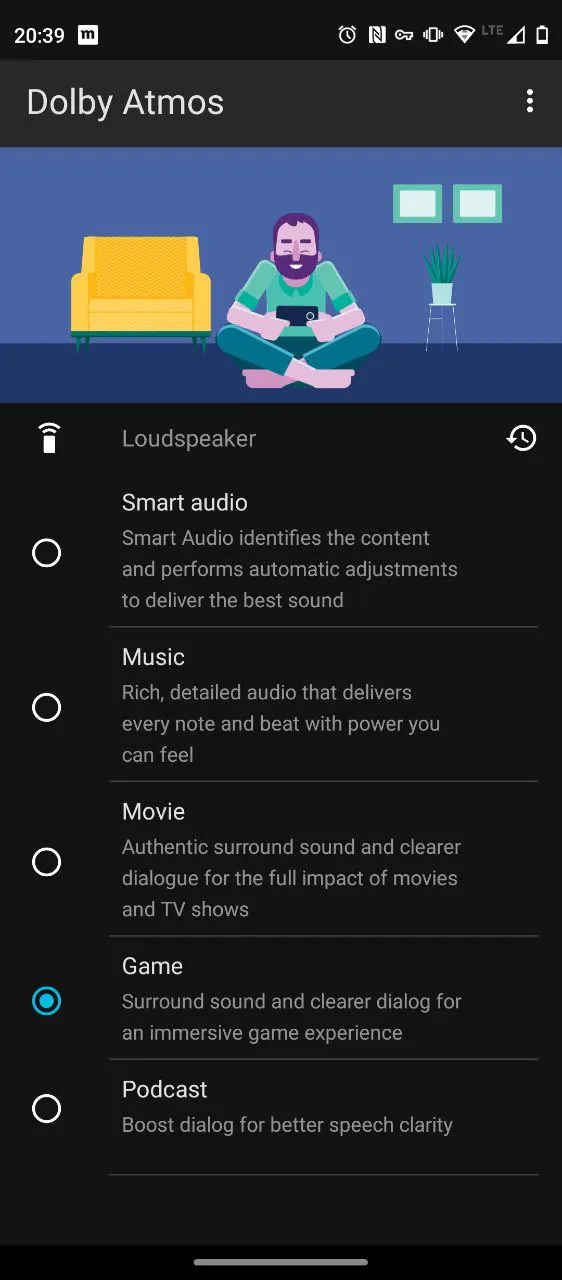
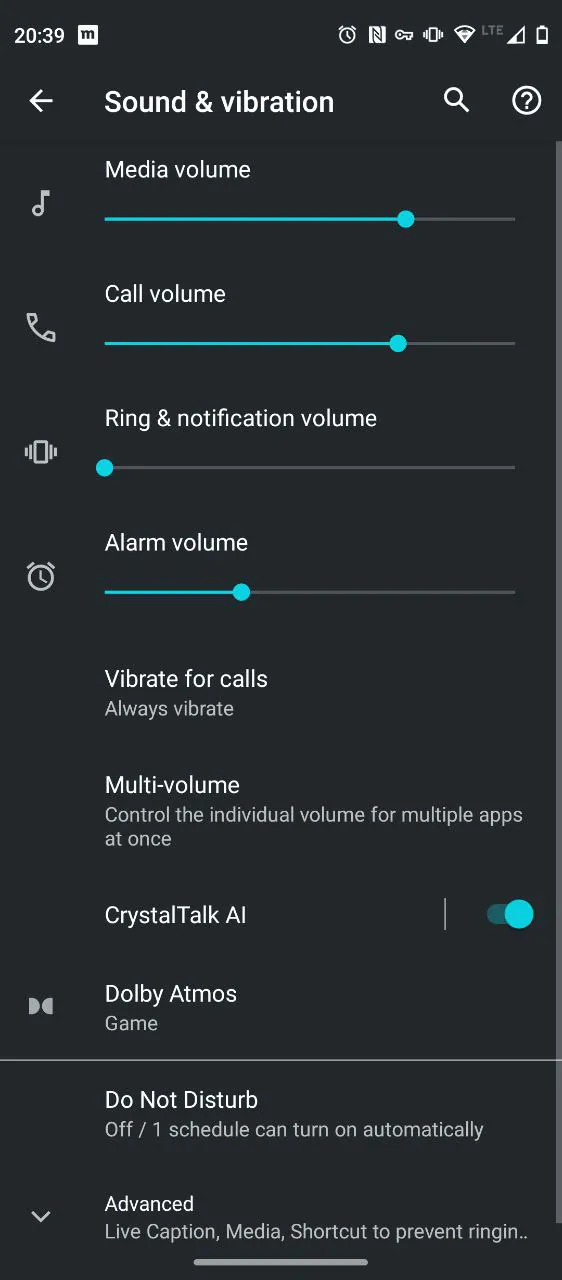
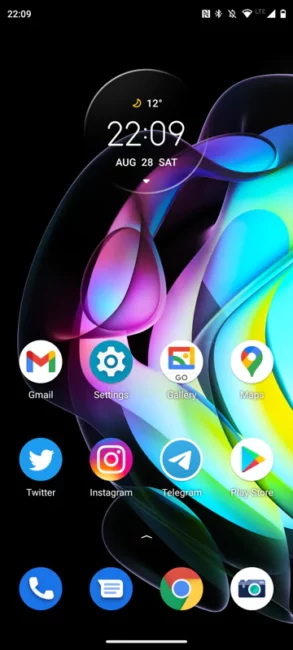
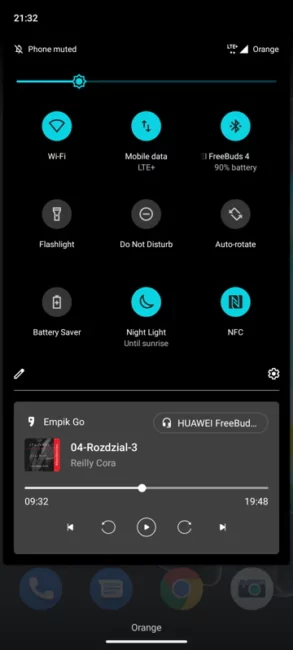
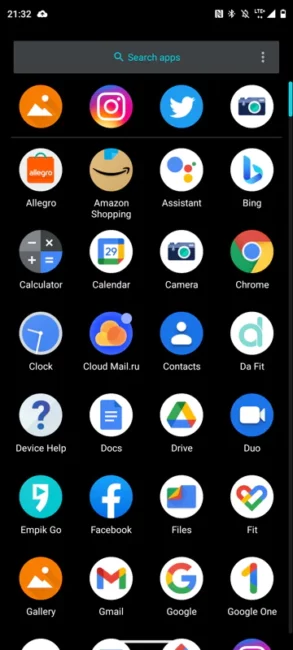
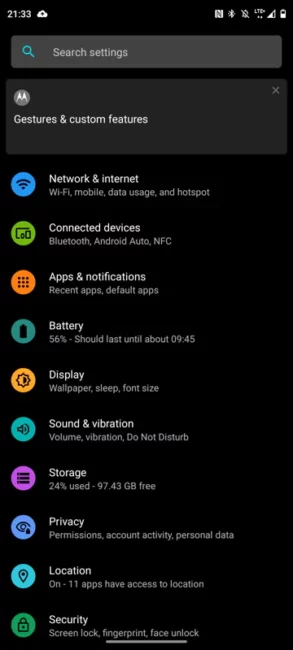
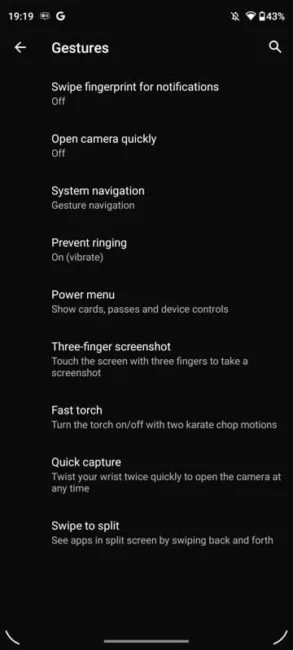
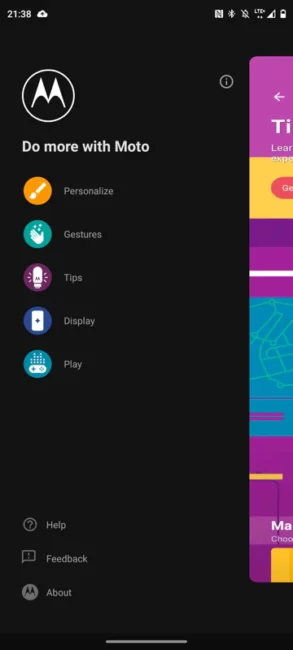

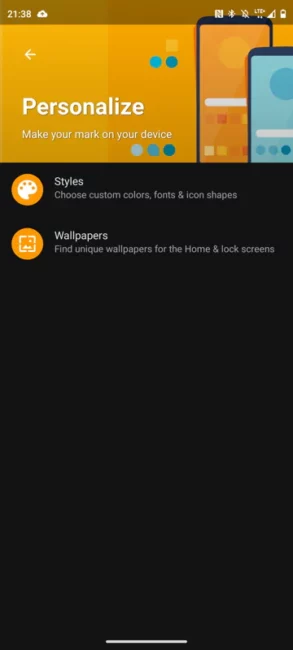
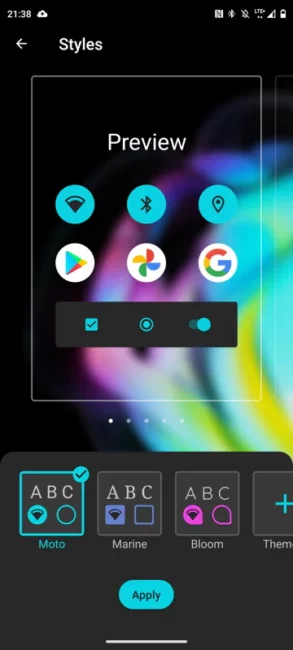

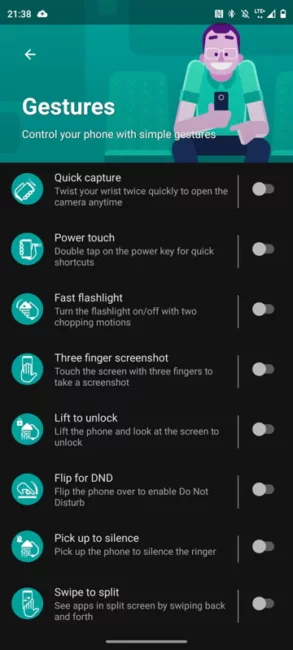
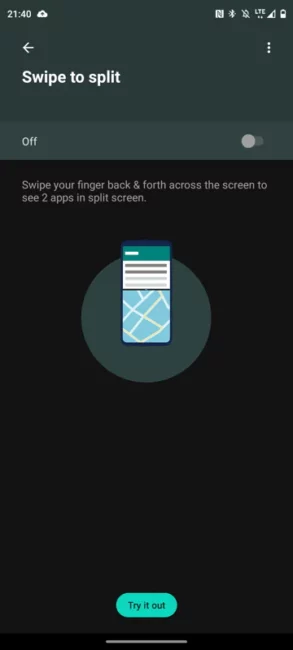
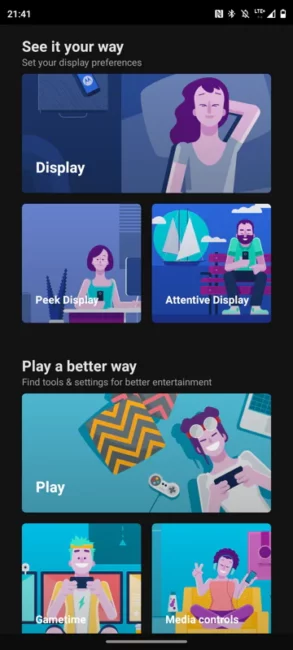
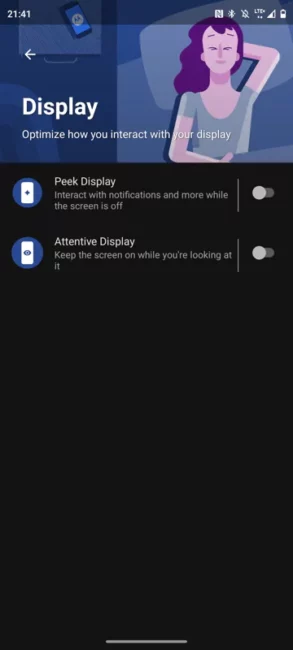
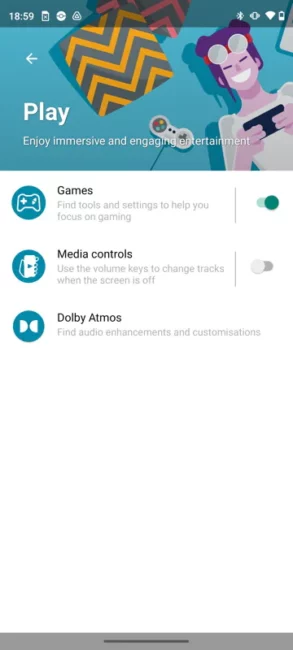
Do you know if the Motorola G200 5g can “stream” 4k? If I connect a sufficient usb c to hdmi cable and play a YouTube video at 4k, will it be 4k on my TV/projector?
Yes, there is useful information – https://forums.lenovo.com/t5/moto-g100/Ready-for-supports-4k/m-p/5079001